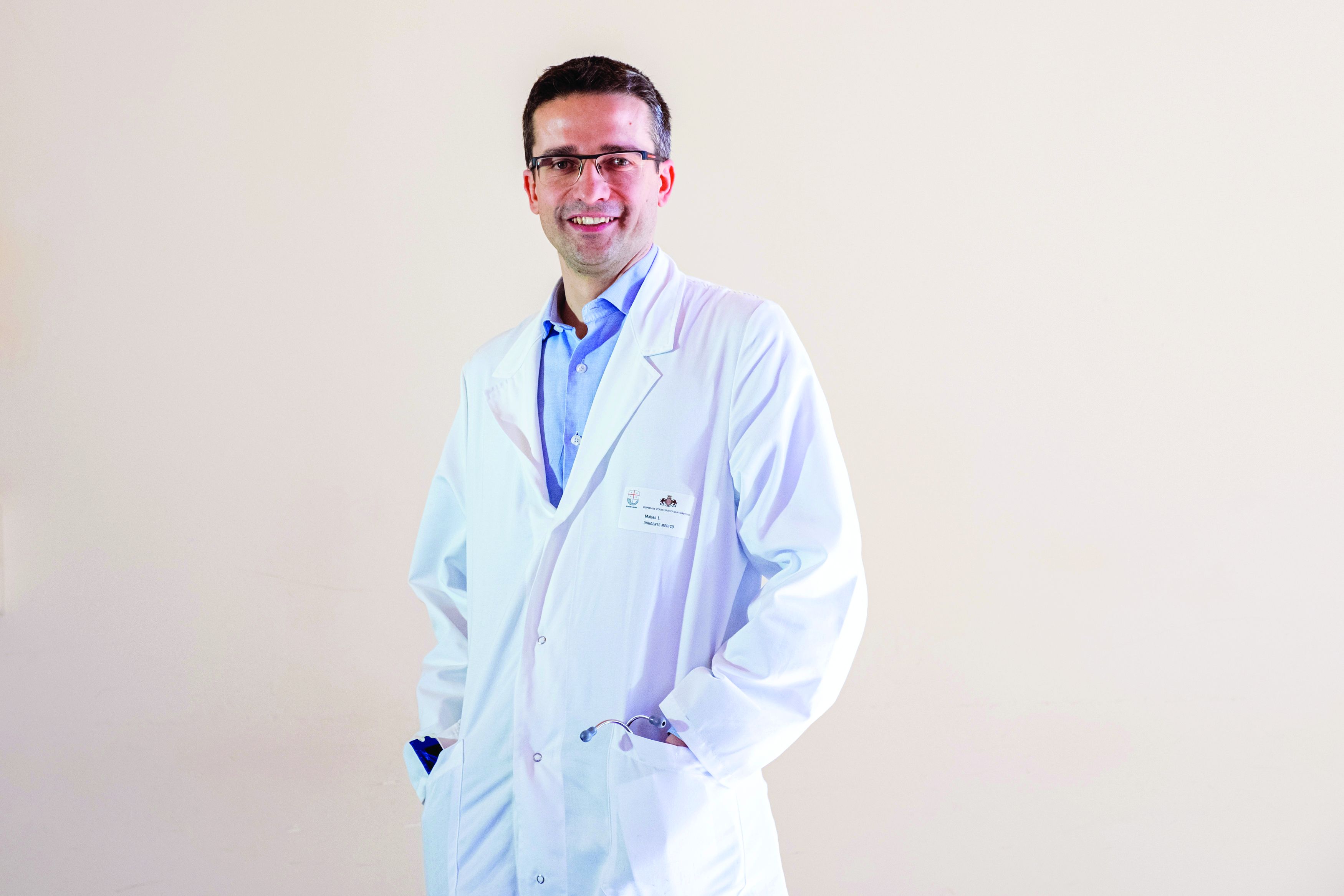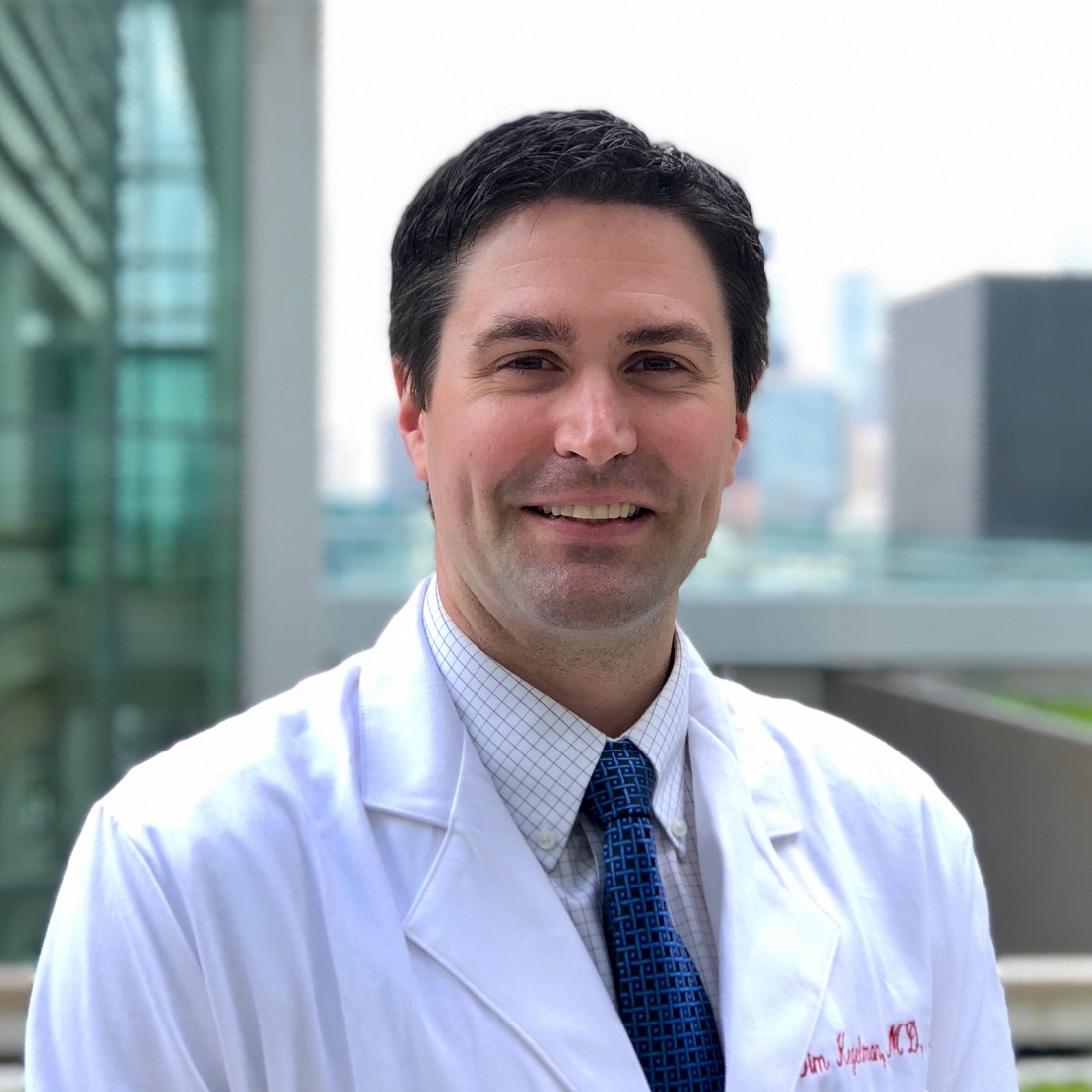User login
Pregnancy after breast cancer is rockier but doesn’t increase recurrence risk
Breast cancer survivors are less likely to get pregnant and have higher risks of some delivery and fetal complications, according to a meta-analysis reported at the 2020 San Antonio Breast Cancer Symposium.
However, the data also showed that pregnancy does not increase the risk of cancer recurrence.
“With the availability of more effective anticancer treatments, survivorship and addressing the treatments’ potential long-term toxicities has gained substantial attention,” said study investigator Matteo Lambertini, MD, PhD, of University of Genova (Italy) – IRCCS Policlinico San Martino Hospital.
“Returning to a normal life after cancer diagnosis and treatment should be considered, in the 21st century, as a crucial ambition in cancer care,” Dr. Lambertini added. “In patients diagnosed during their reproductive years, this includes the possibility to complete their family planning. Due to the constant rise in age at first pregnancy over the past years, many women are diagnosed with breast cancer before completing their reproductive plans.”
In that context, certain cancer treatments have the potential to reduce fertility. In addition, many women need prolonged hormone therapy, and conception is contraindicated while they are receiving it.
Study results
Dr. Lambertini and colleagues performed a meta-analysis using data from 39 studies that included a total of 114,573 breast cancer patients and 8,093,401 women from the general population.
Results showed that breast cancer survivors were much less likely than women in the general population to become pregnant (relative risk, 0.40; P < .001).
However, “the majority of the studies included in our meta-analysis did not capture the information on how many women tried to get pregnant,” Dr. Lambertini cautioned.
In the few studies that did, more than half of women trying to conceive did become pregnant, and most of them were able to do so naturally, without need for assisted reproductive technologies.
On the flip side, analyses also showed that pregnancies occurred in some women who did not want to conceive, underscoring the importance of comprehensive oncofertility counseling that addresses not only fertility preservation, but also contraception, Dr. Lambertini said.
Among women who became pregnant, breast cancer survivors did not have higher odds of spontaneous abortion or complications such as preeclampsia, and their infants were not significantly more likely to have congenital abnormalities.
However, the breast cancer survivor group did have higher odds of cesarean birth (odds ratio, 1.14; P = .007), low birth weight (OR, 1.50; P < .001), preterm birth (OR, 1.45; P = .006), and infants small for gestational age (OR, 1.16; P = .039).
In stratified analysis, the higher risk of having an infant with low birth weight was significant only for women who had received chemotherapy, and the higher risk of having an infant small for gestational age was significant only for women who had received chemotherapy or who had a late pregnancy (more than 2 years to 5 years after cancer diagnosis).
Among breast cancer survivors, those who became pregnant actually had lower risks of disease-free survival events (hazard ratio, 0.73; P = .016) and death (HR, 0.56; P < .001). Findings were similar in the subset of studies that adjusted for the so-called healthy mother effect.
Pregnancy did not significantly affect disease-free survival among women with hormone receptor–positive disease and appeared protective among women with hormone receptor–negative disease (HR, 0.72).
Pregnancy also appeared safe in terms of overall survival, irrespective of survivors’ BRCA status, nodal status, receipt of chemotherapy, pregnancy outcome (completed vs. abortion), and pregnancy interval.
This study was limited by the lack of patient-level data and by the fact that most of the included studies had a retrospective design, Dr. Lambertini acknowledged.
Close monitoring, early discussions are key
“Results of this meta-analysis provide reassuring, updated evidence on the feasibility and safety of conceiving in young women with prior breast cancer diagnosis. They provide crucial information for improving the oncofertility counseling of young breast cancer patients, helping them and their treating physicians in making evidence-based decisions on future family planning,” Dr. Lambertini commented.
“The higher risk of delivery and fetal complications … calls for ensuring a closer monitoring of these pregnancies,” he added. “The lack of detrimental prognostic effect of pregnancy after breast cancer following appropriate treatment and follow-up strongly voices the need for a deeper consideration of patients’ pregnancy desire as a crucial component of their survivorship care plan and wish to return to a normal life.”
“The findings provide further support regarding the safety of pregnancy following a breast cancer diagnosis,” agreed Halle Moore, MD, of Cleveland Clinic Taussig Cancer Institute in Ohio, who was not involved in this study.
“I would add that we still have a lot to learn about optimal timing of pregnancy with respect to breast cancer treatment for women with hormone-sensitive breast cancer treated with endocrine therapy,” she said.
The study’s results serve as a reminder that providers should be routinely discussing future pregnancy wishes and fertility preservation options with breast cancer patients at the time of initial diagnosis, Dr. Moore said.
“The earlier we identify an interest in future fertility, the more we can do to improve the chances for a successful pregnancy outcome,” she elaborated. “It is important to assess interest in future pregnancy as soon as possible when a young woman is diagnosed with breast cancer, as fertility preservation options are most likely to be successful when applied prior to chemotherapy or hormonal treatment for breast cancer.”
“The findings also suggest that involvement of a high-risk obstetrics team should be considered for pregnant breast cancer survivors,” Dr. Moore noted.
This research was funded by the Italian Ministry of Health and the Italian Association for Cancer Research. Dr. Lambertini and Dr. Moore disclosed no conflicts of interest. Eva Blondeaux, MD, of University of Genova – IRCCS Policlinico San Martino Hospital, who presented this research at the meeting, disclosed no conflicts as well.
SOURCE: Blondeaux e et al. SABCS 2020, Abstract GS3-09.
Breast cancer survivors are less likely to get pregnant and have higher risks of some delivery and fetal complications, according to a meta-analysis reported at the 2020 San Antonio Breast Cancer Symposium.
However, the data also showed that pregnancy does not increase the risk of cancer recurrence.
“With the availability of more effective anticancer treatments, survivorship and addressing the treatments’ potential long-term toxicities has gained substantial attention,” said study investigator Matteo Lambertini, MD, PhD, of University of Genova (Italy) – IRCCS Policlinico San Martino Hospital.
“Returning to a normal life after cancer diagnosis and treatment should be considered, in the 21st century, as a crucial ambition in cancer care,” Dr. Lambertini added. “In patients diagnosed during their reproductive years, this includes the possibility to complete their family planning. Due to the constant rise in age at first pregnancy over the past years, many women are diagnosed with breast cancer before completing their reproductive plans.”
In that context, certain cancer treatments have the potential to reduce fertility. In addition, many women need prolonged hormone therapy, and conception is contraindicated while they are receiving it.
Study results
Dr. Lambertini and colleagues performed a meta-analysis using data from 39 studies that included a total of 114,573 breast cancer patients and 8,093,401 women from the general population.
Results showed that breast cancer survivors were much less likely than women in the general population to become pregnant (relative risk, 0.40; P < .001).
However, “the majority of the studies included in our meta-analysis did not capture the information on how many women tried to get pregnant,” Dr. Lambertini cautioned.
In the few studies that did, more than half of women trying to conceive did become pregnant, and most of them were able to do so naturally, without need for assisted reproductive technologies.
On the flip side, analyses also showed that pregnancies occurred in some women who did not want to conceive, underscoring the importance of comprehensive oncofertility counseling that addresses not only fertility preservation, but also contraception, Dr. Lambertini said.
Among women who became pregnant, breast cancer survivors did not have higher odds of spontaneous abortion or complications such as preeclampsia, and their infants were not significantly more likely to have congenital abnormalities.
However, the breast cancer survivor group did have higher odds of cesarean birth (odds ratio, 1.14; P = .007), low birth weight (OR, 1.50; P < .001), preterm birth (OR, 1.45; P = .006), and infants small for gestational age (OR, 1.16; P = .039).
In stratified analysis, the higher risk of having an infant with low birth weight was significant only for women who had received chemotherapy, and the higher risk of having an infant small for gestational age was significant only for women who had received chemotherapy or who had a late pregnancy (more than 2 years to 5 years after cancer diagnosis).
Among breast cancer survivors, those who became pregnant actually had lower risks of disease-free survival events (hazard ratio, 0.73; P = .016) and death (HR, 0.56; P < .001). Findings were similar in the subset of studies that adjusted for the so-called healthy mother effect.
Pregnancy did not significantly affect disease-free survival among women with hormone receptor–positive disease and appeared protective among women with hormone receptor–negative disease (HR, 0.72).
Pregnancy also appeared safe in terms of overall survival, irrespective of survivors’ BRCA status, nodal status, receipt of chemotherapy, pregnancy outcome (completed vs. abortion), and pregnancy interval.
This study was limited by the lack of patient-level data and by the fact that most of the included studies had a retrospective design, Dr. Lambertini acknowledged.
Close monitoring, early discussions are key
“Results of this meta-analysis provide reassuring, updated evidence on the feasibility and safety of conceiving in young women with prior breast cancer diagnosis. They provide crucial information for improving the oncofertility counseling of young breast cancer patients, helping them and their treating physicians in making evidence-based decisions on future family planning,” Dr. Lambertini commented.
“The higher risk of delivery and fetal complications … calls for ensuring a closer monitoring of these pregnancies,” he added. “The lack of detrimental prognostic effect of pregnancy after breast cancer following appropriate treatment and follow-up strongly voices the need for a deeper consideration of patients’ pregnancy desire as a crucial component of their survivorship care plan and wish to return to a normal life.”
“The findings provide further support regarding the safety of pregnancy following a breast cancer diagnosis,” agreed Halle Moore, MD, of Cleveland Clinic Taussig Cancer Institute in Ohio, who was not involved in this study.
“I would add that we still have a lot to learn about optimal timing of pregnancy with respect to breast cancer treatment for women with hormone-sensitive breast cancer treated with endocrine therapy,” she said.
The study’s results serve as a reminder that providers should be routinely discussing future pregnancy wishes and fertility preservation options with breast cancer patients at the time of initial diagnosis, Dr. Moore said.
“The earlier we identify an interest in future fertility, the more we can do to improve the chances for a successful pregnancy outcome,” she elaborated. “It is important to assess interest in future pregnancy as soon as possible when a young woman is diagnosed with breast cancer, as fertility preservation options are most likely to be successful when applied prior to chemotherapy or hormonal treatment for breast cancer.”
“The findings also suggest that involvement of a high-risk obstetrics team should be considered for pregnant breast cancer survivors,” Dr. Moore noted.
This research was funded by the Italian Ministry of Health and the Italian Association for Cancer Research. Dr. Lambertini and Dr. Moore disclosed no conflicts of interest. Eva Blondeaux, MD, of University of Genova – IRCCS Policlinico San Martino Hospital, who presented this research at the meeting, disclosed no conflicts as well.
SOURCE: Blondeaux e et al. SABCS 2020, Abstract GS3-09.
Breast cancer survivors are less likely to get pregnant and have higher risks of some delivery and fetal complications, according to a meta-analysis reported at the 2020 San Antonio Breast Cancer Symposium.
However, the data also showed that pregnancy does not increase the risk of cancer recurrence.
“With the availability of more effective anticancer treatments, survivorship and addressing the treatments’ potential long-term toxicities has gained substantial attention,” said study investigator Matteo Lambertini, MD, PhD, of University of Genova (Italy) – IRCCS Policlinico San Martino Hospital.
“Returning to a normal life after cancer diagnosis and treatment should be considered, in the 21st century, as a crucial ambition in cancer care,” Dr. Lambertini added. “In patients diagnosed during their reproductive years, this includes the possibility to complete their family planning. Due to the constant rise in age at first pregnancy over the past years, many women are diagnosed with breast cancer before completing their reproductive plans.”
In that context, certain cancer treatments have the potential to reduce fertility. In addition, many women need prolonged hormone therapy, and conception is contraindicated while they are receiving it.
Study results
Dr. Lambertini and colleagues performed a meta-analysis using data from 39 studies that included a total of 114,573 breast cancer patients and 8,093,401 women from the general population.
Results showed that breast cancer survivors were much less likely than women in the general population to become pregnant (relative risk, 0.40; P < .001).
However, “the majority of the studies included in our meta-analysis did not capture the information on how many women tried to get pregnant,” Dr. Lambertini cautioned.
In the few studies that did, more than half of women trying to conceive did become pregnant, and most of them were able to do so naturally, without need for assisted reproductive technologies.
On the flip side, analyses also showed that pregnancies occurred in some women who did not want to conceive, underscoring the importance of comprehensive oncofertility counseling that addresses not only fertility preservation, but also contraception, Dr. Lambertini said.
Among women who became pregnant, breast cancer survivors did not have higher odds of spontaneous abortion or complications such as preeclampsia, and their infants were not significantly more likely to have congenital abnormalities.
However, the breast cancer survivor group did have higher odds of cesarean birth (odds ratio, 1.14; P = .007), low birth weight (OR, 1.50; P < .001), preterm birth (OR, 1.45; P = .006), and infants small for gestational age (OR, 1.16; P = .039).
In stratified analysis, the higher risk of having an infant with low birth weight was significant only for women who had received chemotherapy, and the higher risk of having an infant small for gestational age was significant only for women who had received chemotherapy or who had a late pregnancy (more than 2 years to 5 years after cancer diagnosis).
Among breast cancer survivors, those who became pregnant actually had lower risks of disease-free survival events (hazard ratio, 0.73; P = .016) and death (HR, 0.56; P < .001). Findings were similar in the subset of studies that adjusted for the so-called healthy mother effect.
Pregnancy did not significantly affect disease-free survival among women with hormone receptor–positive disease and appeared protective among women with hormone receptor–negative disease (HR, 0.72).
Pregnancy also appeared safe in terms of overall survival, irrespective of survivors’ BRCA status, nodal status, receipt of chemotherapy, pregnancy outcome (completed vs. abortion), and pregnancy interval.
This study was limited by the lack of patient-level data and by the fact that most of the included studies had a retrospective design, Dr. Lambertini acknowledged.
Close monitoring, early discussions are key
“Results of this meta-analysis provide reassuring, updated evidence on the feasibility and safety of conceiving in young women with prior breast cancer diagnosis. They provide crucial information for improving the oncofertility counseling of young breast cancer patients, helping them and their treating physicians in making evidence-based decisions on future family planning,” Dr. Lambertini commented.
“The higher risk of delivery and fetal complications … calls for ensuring a closer monitoring of these pregnancies,” he added. “The lack of detrimental prognostic effect of pregnancy after breast cancer following appropriate treatment and follow-up strongly voices the need for a deeper consideration of patients’ pregnancy desire as a crucial component of their survivorship care plan and wish to return to a normal life.”
“The findings provide further support regarding the safety of pregnancy following a breast cancer diagnosis,” agreed Halle Moore, MD, of Cleveland Clinic Taussig Cancer Institute in Ohio, who was not involved in this study.
“I would add that we still have a lot to learn about optimal timing of pregnancy with respect to breast cancer treatment for women with hormone-sensitive breast cancer treated with endocrine therapy,” she said.
The study’s results serve as a reminder that providers should be routinely discussing future pregnancy wishes and fertility preservation options with breast cancer patients at the time of initial diagnosis, Dr. Moore said.
“The earlier we identify an interest in future fertility, the more we can do to improve the chances for a successful pregnancy outcome,” she elaborated. “It is important to assess interest in future pregnancy as soon as possible when a young woman is diagnosed with breast cancer, as fertility preservation options are most likely to be successful when applied prior to chemotherapy or hormonal treatment for breast cancer.”
“The findings also suggest that involvement of a high-risk obstetrics team should be considered for pregnant breast cancer survivors,” Dr. Moore noted.
This research was funded by the Italian Ministry of Health and the Italian Association for Cancer Research. Dr. Lambertini and Dr. Moore disclosed no conflicts of interest. Eva Blondeaux, MD, of University of Genova – IRCCS Policlinico San Martino Hospital, who presented this research at the meeting, disclosed no conflicts as well.
SOURCE: Blondeaux e et al. SABCS 2020, Abstract GS3-09.
FROM SABCS 2020
Focal radiation boost nets better outcomes in prostate cancer
The results were reported at the European Society for Radiology and Oncology 2020 Online Congress.
“We know that local recurrences most often occur at the location of the primary tumor or the dominant intraprostatic lesion, and we also know that biochemical disease–free survival improves with increasing dose to the whole prostate gland,” said principal investigator Linda G.W. Kerkmeijer, MD, PhD, of Radboud University Medical Center Nijmegen, the Netherlands.
However, “with whole-gland dose escalation, increased toxicity has been observed in both external-beam and brachytherapy trials,” she added.
FLAME trial details
A total of 571 patients took part in the FLAME trial, which is a collaboration of UMC Utrecht, the Netherlands Cancer Institute, University Hospitals Leuven, and Radboudumc.
The patients were randomized evenly to standard radiation therapy alone (77 Gy to the whole prostate in 35 fractions of 2.2 Gy) or with an integrated boost to the macroscopically visible tumor on multiparametric MRI (to reach a total dose of up to 95 Gy in 35 fractions of 2.7 Gy).
In treatment planning, the organs-at-risk constraints were prioritized over the focal boost dose, Dr. Kerkmeijer pointed out.
A majority of patients (84%) had high-risk disease, and two-thirds received hormonal therapy (usually in the adjuvant setting) with equal distribution across study arms, she reported.
With a median follow-up of 72 months, the 5-year rate of biochemical disease–free survival, the trial’s primary endpoint, was superior with the addition of the focal boost as compared with standard radiation therapy alone (92% vs. 85%; P < .001).
The boost also netted significantly better disease-free survival (P < .001).
The arms were similar on distant metastasis–free survival (P = .26), prostate cancer–specific survival (P = .49), and overall survival (P = .50), although longer follow-up is needed to fully assess these outcomes, Dr. Kerkmeijer noted.
The boost and standard therapy arms had much the same late grade 3 or higher genitourinary toxicity (5.6% vs. 3.5%; P = .22) and late grade 3 or higher gastrointestinal toxicity (1.4% vs. 1.4%; P = .99).
The arms were essentially identical on long-term patient-reported urinary symptoms, bowel symptoms, sexual activity, and sexual function, as measured with the EORTC QLQ-PR25 tool and detailed in a companion presentation (abstract OC-0315).
‘A standard option’ and next steps
“FLAME is the first phase 3 randomized controlled trial to show that focal boosting works and that biochemical recurrence was reduced at 5 years,” Dr. Kerkmeijer said. “We propose that the FLAME scheme can be considered as a standard option for patients with intermediate- but especially high-risk prostate cancer.”
“For patients, biochemical recurrence may have impact, as this causes additional follow-up and diagnostic exams, potential anxiety, and potential side effects of subsequent treatments,” she added. “Biochemical recurrences were reduced by almost half and at no additional cost and no additional toxicity by this FLAME isotoxic approach and by using conventional radiotherapy techniques.”
The next step is pairing the boost with ultra-hypofractionation, which requires highly accurate targeting, Dr. Kerkmeijer said. In fact, favorable early toxicity results of the subsequent Hypo-FLAME trial, which tested this strategy, were also reported at the congress (abstract OC-0209), and a trial taking the strategy even further, Hypo-FLAME 2.0, is ongoing.
“The FLAME trial’s results are probably true but may have been impacted by the use of hormonal therapy,” Anthony V. D’Amico, MD, PhD, of the Dana Farber Cancer Institute and Harvard Medical School, Boston, said in an interview.
Any imbalance in the use and duration of hormonal therapy, given that it can delay the time to prostate-specific antigen failure, could lead to overestimation or underestimation of the benefit of the focal boost, with respect to the primary endpoint of the study, he elaborated. Typical durations of this therapy range from 4 to 6 months for patients with intermediate-risk disease and from 18 to 36 months for patients with high-risk disease.
“So it’s important to know and to adjust not just for hormonal therapy use, but for duration between the two arms, stratified by risk group, in a multivariable regression analysis,” Dr. D’Amico concluded.
The FLAME trial was funded by the Dutch Cancer Society and Stand Up Against Cancer Belgium. Dr. Kerkmeijer and Dr. D’Amico disclosed having no conflicts of interest.
SOURCE: De Boer HCJ et al. ESTRO 2020. Abstract OC-0612.
The results were reported at the European Society for Radiology and Oncology 2020 Online Congress.
“We know that local recurrences most often occur at the location of the primary tumor or the dominant intraprostatic lesion, and we also know that biochemical disease–free survival improves with increasing dose to the whole prostate gland,” said principal investigator Linda G.W. Kerkmeijer, MD, PhD, of Radboud University Medical Center Nijmegen, the Netherlands.
However, “with whole-gland dose escalation, increased toxicity has been observed in both external-beam and brachytherapy trials,” she added.
FLAME trial details
A total of 571 patients took part in the FLAME trial, which is a collaboration of UMC Utrecht, the Netherlands Cancer Institute, University Hospitals Leuven, and Radboudumc.
The patients were randomized evenly to standard radiation therapy alone (77 Gy to the whole prostate in 35 fractions of 2.2 Gy) or with an integrated boost to the macroscopically visible tumor on multiparametric MRI (to reach a total dose of up to 95 Gy in 35 fractions of 2.7 Gy).
In treatment planning, the organs-at-risk constraints were prioritized over the focal boost dose, Dr. Kerkmeijer pointed out.
A majority of patients (84%) had high-risk disease, and two-thirds received hormonal therapy (usually in the adjuvant setting) with equal distribution across study arms, she reported.
With a median follow-up of 72 months, the 5-year rate of biochemical disease–free survival, the trial’s primary endpoint, was superior with the addition of the focal boost as compared with standard radiation therapy alone (92% vs. 85%; P < .001).
The boost also netted significantly better disease-free survival (P < .001).
The arms were similar on distant metastasis–free survival (P = .26), prostate cancer–specific survival (P = .49), and overall survival (P = .50), although longer follow-up is needed to fully assess these outcomes, Dr. Kerkmeijer noted.
The boost and standard therapy arms had much the same late grade 3 or higher genitourinary toxicity (5.6% vs. 3.5%; P = .22) and late grade 3 or higher gastrointestinal toxicity (1.4% vs. 1.4%; P = .99).
The arms were essentially identical on long-term patient-reported urinary symptoms, bowel symptoms, sexual activity, and sexual function, as measured with the EORTC QLQ-PR25 tool and detailed in a companion presentation (abstract OC-0315).
‘A standard option’ and next steps
“FLAME is the first phase 3 randomized controlled trial to show that focal boosting works and that biochemical recurrence was reduced at 5 years,” Dr. Kerkmeijer said. “We propose that the FLAME scheme can be considered as a standard option for patients with intermediate- but especially high-risk prostate cancer.”
“For patients, biochemical recurrence may have impact, as this causes additional follow-up and diagnostic exams, potential anxiety, and potential side effects of subsequent treatments,” she added. “Biochemical recurrences were reduced by almost half and at no additional cost and no additional toxicity by this FLAME isotoxic approach and by using conventional radiotherapy techniques.”
The next step is pairing the boost with ultra-hypofractionation, which requires highly accurate targeting, Dr. Kerkmeijer said. In fact, favorable early toxicity results of the subsequent Hypo-FLAME trial, which tested this strategy, were also reported at the congress (abstract OC-0209), and a trial taking the strategy even further, Hypo-FLAME 2.0, is ongoing.
“The FLAME trial’s results are probably true but may have been impacted by the use of hormonal therapy,” Anthony V. D’Amico, MD, PhD, of the Dana Farber Cancer Institute and Harvard Medical School, Boston, said in an interview.
Any imbalance in the use and duration of hormonal therapy, given that it can delay the time to prostate-specific antigen failure, could lead to overestimation or underestimation of the benefit of the focal boost, with respect to the primary endpoint of the study, he elaborated. Typical durations of this therapy range from 4 to 6 months for patients with intermediate-risk disease and from 18 to 36 months for patients with high-risk disease.
“So it’s important to know and to adjust not just for hormonal therapy use, but for duration between the two arms, stratified by risk group, in a multivariable regression analysis,” Dr. D’Amico concluded.
The FLAME trial was funded by the Dutch Cancer Society and Stand Up Against Cancer Belgium. Dr. Kerkmeijer and Dr. D’Amico disclosed having no conflicts of interest.
SOURCE: De Boer HCJ et al. ESTRO 2020. Abstract OC-0612.
The results were reported at the European Society for Radiology and Oncology 2020 Online Congress.
“We know that local recurrences most often occur at the location of the primary tumor or the dominant intraprostatic lesion, and we also know that biochemical disease–free survival improves with increasing dose to the whole prostate gland,” said principal investigator Linda G.W. Kerkmeijer, MD, PhD, of Radboud University Medical Center Nijmegen, the Netherlands.
However, “with whole-gland dose escalation, increased toxicity has been observed in both external-beam and brachytherapy trials,” she added.
FLAME trial details
A total of 571 patients took part in the FLAME trial, which is a collaboration of UMC Utrecht, the Netherlands Cancer Institute, University Hospitals Leuven, and Radboudumc.
The patients were randomized evenly to standard radiation therapy alone (77 Gy to the whole prostate in 35 fractions of 2.2 Gy) or with an integrated boost to the macroscopically visible tumor on multiparametric MRI (to reach a total dose of up to 95 Gy in 35 fractions of 2.7 Gy).
In treatment planning, the organs-at-risk constraints were prioritized over the focal boost dose, Dr. Kerkmeijer pointed out.
A majority of patients (84%) had high-risk disease, and two-thirds received hormonal therapy (usually in the adjuvant setting) with equal distribution across study arms, she reported.
With a median follow-up of 72 months, the 5-year rate of biochemical disease–free survival, the trial’s primary endpoint, was superior with the addition of the focal boost as compared with standard radiation therapy alone (92% vs. 85%; P < .001).
The boost also netted significantly better disease-free survival (P < .001).
The arms were similar on distant metastasis–free survival (P = .26), prostate cancer–specific survival (P = .49), and overall survival (P = .50), although longer follow-up is needed to fully assess these outcomes, Dr. Kerkmeijer noted.
The boost and standard therapy arms had much the same late grade 3 or higher genitourinary toxicity (5.6% vs. 3.5%; P = .22) and late grade 3 or higher gastrointestinal toxicity (1.4% vs. 1.4%; P = .99).
The arms were essentially identical on long-term patient-reported urinary symptoms, bowel symptoms, sexual activity, and sexual function, as measured with the EORTC QLQ-PR25 tool and detailed in a companion presentation (abstract OC-0315).
‘A standard option’ and next steps
“FLAME is the first phase 3 randomized controlled trial to show that focal boosting works and that biochemical recurrence was reduced at 5 years,” Dr. Kerkmeijer said. “We propose that the FLAME scheme can be considered as a standard option for patients with intermediate- but especially high-risk prostate cancer.”
“For patients, biochemical recurrence may have impact, as this causes additional follow-up and diagnostic exams, potential anxiety, and potential side effects of subsequent treatments,” she added. “Biochemical recurrences were reduced by almost half and at no additional cost and no additional toxicity by this FLAME isotoxic approach and by using conventional radiotherapy techniques.”
The next step is pairing the boost with ultra-hypofractionation, which requires highly accurate targeting, Dr. Kerkmeijer said. In fact, favorable early toxicity results of the subsequent Hypo-FLAME trial, which tested this strategy, were also reported at the congress (abstract OC-0209), and a trial taking the strategy even further, Hypo-FLAME 2.0, is ongoing.
“The FLAME trial’s results are probably true but may have been impacted by the use of hormonal therapy,” Anthony V. D’Amico, MD, PhD, of the Dana Farber Cancer Institute and Harvard Medical School, Boston, said in an interview.
Any imbalance in the use and duration of hormonal therapy, given that it can delay the time to prostate-specific antigen failure, could lead to overestimation or underestimation of the benefit of the focal boost, with respect to the primary endpoint of the study, he elaborated. Typical durations of this therapy range from 4 to 6 months for patients with intermediate-risk disease and from 18 to 36 months for patients with high-risk disease.
“So it’s important to know and to adjust not just for hormonal therapy use, but for duration between the two arms, stratified by risk group, in a multivariable regression analysis,” Dr. D’Amico concluded.
The FLAME trial was funded by the Dutch Cancer Society and Stand Up Against Cancer Belgium. Dr. Kerkmeijer and Dr. D’Amico disclosed having no conflicts of interest.
SOURCE: De Boer HCJ et al. ESTRO 2020. Abstract OC-0612.
FROM ESTRO 2020
Breast surgery may be a gateway to addictive medication use
After their surgery, 13.1% of opioid-naive patients become new persistent opioid users, and 6.6% of sedative-hypnotic–naive patients become new persistent users of sedative-hypnotics. Risk factors for persistent substance use included younger age, a breast cancer diagnosis, and chemotherapy.
“As the opioid epidemic in the United States continues, the rate of opioid dependence in the cancer population continues to increase as well,” study investigator Jacob Cogan, MD, of NewYork-Presbyterian/Columbia University Irving Medical Center in New York, said during a press conference.
“The perioperative period is one of high risk for cancer patients, with up to 10% becoming new persistent opioid users after cancer-related surgery. The rates surrounding mastectomy and reconstruction, however, are unknown. Another class of controlled substances worth our attention are the sedative-hypnotics. Despite the high rates of psychiatric disorders in the cancer population, there is little research into the rates of persistent sedative-hypnotic use in these patients.”
With this in mind, Dr. Cogan and colleagues analyzed MarketScan health care claims data for patients who underwent mastectomy and reconstruction (whether therapeutic or prophylactic) between 2008 and 2017.
The researchers then identified prescription claims for opioids and sedative-hypnotics during three periods:
- Preoperative period – 365 days to 31 days before surgery.
- Perioperative period – 31 days before to 90 days after surgery.
- Postoperative period – 90 days to 365 days after surgery.
‘Striking’ results
Analyses were based on 25,270 women who were not prior users of opioids and 27,651 women who were not prior users of sedative-hypnotics.
Women were considered new persistent substance users if they had no use in the preoperative period but filled at least one prescription in the perioperative period and at least two in the postoperative period.
Overall, 13.1% of opioid-naive patients became persistent opioid users, and 6.6% of sedative-hypnotic-naive patients became persistent sedative-hypnotic users after their mastectomy and reconstruction.
Proportions of substance use were even higher, 17.5% for opioids and 17.0% for sedative-hypnotics, after excluding women who did not receive or fill a perioperative prescription.
In multivariate analysis, patients were significantly more likely to become new persistent opioid users if they had Medicaid insurance (odds ratio, 2.31), had a breast cancer diagnosis vs a prophylactic indication (OR, 1.44), received chemotherapy (OR, 1.33), and were 50-64 years of age (OR, 1.29) or 49 years or younger (OR, 1.27), compared with 65 years or older.
Similarly, patients were significantly more likely to become new persistent sedative-hypnotic users if they received chemotherapy (OR, 2.24), had Medicaid insurance (OR, 1.85), had a breast cancer diagnosis (OR, 1.79), and were 50 to 64 years (OR, 1.65) or 49 years or younger (OR, 1.79).
Finally, patients’ likelihood of new persistent use increased with their number of risk factors. For persistent opioid use, the odds ratio rose from 2.27 in patients with two risk factors to 6.34 in those with five risk factors. For persistent sedative-hypnotic use, the odds ratio rose from 2.55 to 7.71, respectively.
The observed incidences of new persistent substance use in this patient population are “striking,” according to Dr. Cogan. Although the identified risk factors can help providers spot patients who should be monitored more closely, a proactive, systematic approach to postoperative follow-up for all patients is likely needed.
“When you are seeing patients in follow-up, this is something that you might want to explicitly ask about, for example, and not just assume that the postoperative opioids were taken and then disposed of,” Dr. Cogan recommended. “Ask them, ‘Are you still taking opioids, are you still taking your Ambien or whatever medication you were prescribed?’ That’s something to diligently follow up on and make sure the drug is disposed of, or if it somebody is still taking it, refer them for the appropriate services.”
In addition, patients should be encouraged to use over-the-counter medications as much as possible, he advised.
Prescribing: It’s complicated
“I wonder if perhaps we should not be giving opioids at all to certain patients. For example, a mastectomy and implant reconstruction, oftentimes, surprisingly, that’s not a terribly painful procedure. But a TRAM [transverse rectus abdominis] flap or abdominal flap, that really is,” commented press conference comoderator C. Kent Osborne, MD, of Baylor College of Medicine in Houston.
“I’ve been surprised that a lot of my patients get the prescription, but they don’t even use the pills, and I wonder if the prescription is given just so that we’re not bothered at nighttime by somebody calling with pain,” Dr. Osbourne added.
Prescribing opioids for postoperative pain is complicated, Dr. Cogan said, noting that the study did not assess the specific type of reconstruction patients had.
“You don’t want people in pain. Even if they need just one or two pills, it’s still reasonable for them to have it, and we certainly don’t want to imply from our study that people shouldn’t be getting these prescriptions if they need them,” Dr. Cogan elaborated. “But once patients have them, don’t just leave them there in their home because other studies have shown that that’s when people really get addicted to these medications, when they use them later on for other reasons, or they keep using them just because they have them around.”
The risk for persistent use of controlled substances “is something that all physicians need to be aware of for their patients. This is something that we are missing,” maintained press conference comoderator Virginia Kaklamani, MD, DSc, of UT Health San Antonio.
“It’s easy to just give a prescription instead of arguing with a patient about why you are not going to give them a prescription,” Dr. Kaklamani said. “And ultimately ... pain is subjective. If a patient tells you they are in pain, you are, quote-endquote, a bad physician if you tell them they should not be in pain.”
“We need to focus on other ways to deal with the pain, like physical therapy, sending patients to physical medicine and rehab physicians who are trained to help with symptoms from the surgery, with range of motion and all that; that can help with pain,” she recommended. “It’s much harder to do that, right, than to send a prescription in for a narcotic? But that easy answer is always the worst answer.”
This study was funded by the Breast Cancer Research Foundation and the National Institutes of Health. Dr. Cogan declared no conflicts of interest. Dr. Osborne disclosed relationships with Wolters Kluwer, Lilly, Tolmar, and GeneTex. Dr. Kaklamani disclosed relationships with Amgen, AstraZeneca, Athenex, Celgene, Celldex, Daiichi, Eisai, Genentech, Genomic Health, Immunomedics, Novartis, Pfizer, Puma, and Seattle Genetics.
SOURCE: Cogan JC et al. SABCS 2020, Abstract GS3-08.
After their surgery, 13.1% of opioid-naive patients become new persistent opioid users, and 6.6% of sedative-hypnotic–naive patients become new persistent users of sedative-hypnotics. Risk factors for persistent substance use included younger age, a breast cancer diagnosis, and chemotherapy.
“As the opioid epidemic in the United States continues, the rate of opioid dependence in the cancer population continues to increase as well,” study investigator Jacob Cogan, MD, of NewYork-Presbyterian/Columbia University Irving Medical Center in New York, said during a press conference.
“The perioperative period is one of high risk for cancer patients, with up to 10% becoming new persistent opioid users after cancer-related surgery. The rates surrounding mastectomy and reconstruction, however, are unknown. Another class of controlled substances worth our attention are the sedative-hypnotics. Despite the high rates of psychiatric disorders in the cancer population, there is little research into the rates of persistent sedative-hypnotic use in these patients.”
With this in mind, Dr. Cogan and colleagues analyzed MarketScan health care claims data for patients who underwent mastectomy and reconstruction (whether therapeutic or prophylactic) between 2008 and 2017.
The researchers then identified prescription claims for opioids and sedative-hypnotics during three periods:
- Preoperative period – 365 days to 31 days before surgery.
- Perioperative period – 31 days before to 90 days after surgery.
- Postoperative period – 90 days to 365 days after surgery.
‘Striking’ results
Analyses were based on 25,270 women who were not prior users of opioids and 27,651 women who were not prior users of sedative-hypnotics.
Women were considered new persistent substance users if they had no use in the preoperative period but filled at least one prescription in the perioperative period and at least two in the postoperative period.
Overall, 13.1% of opioid-naive patients became persistent opioid users, and 6.6% of sedative-hypnotic-naive patients became persistent sedative-hypnotic users after their mastectomy and reconstruction.
Proportions of substance use were even higher, 17.5% for opioids and 17.0% for sedative-hypnotics, after excluding women who did not receive or fill a perioperative prescription.
In multivariate analysis, patients were significantly more likely to become new persistent opioid users if they had Medicaid insurance (odds ratio, 2.31), had a breast cancer diagnosis vs a prophylactic indication (OR, 1.44), received chemotherapy (OR, 1.33), and were 50-64 years of age (OR, 1.29) or 49 years or younger (OR, 1.27), compared with 65 years or older.
Similarly, patients were significantly more likely to become new persistent sedative-hypnotic users if they received chemotherapy (OR, 2.24), had Medicaid insurance (OR, 1.85), had a breast cancer diagnosis (OR, 1.79), and were 50 to 64 years (OR, 1.65) or 49 years or younger (OR, 1.79).
Finally, patients’ likelihood of new persistent use increased with their number of risk factors. For persistent opioid use, the odds ratio rose from 2.27 in patients with two risk factors to 6.34 in those with five risk factors. For persistent sedative-hypnotic use, the odds ratio rose from 2.55 to 7.71, respectively.
The observed incidences of new persistent substance use in this patient population are “striking,” according to Dr. Cogan. Although the identified risk factors can help providers spot patients who should be monitored more closely, a proactive, systematic approach to postoperative follow-up for all patients is likely needed.
“When you are seeing patients in follow-up, this is something that you might want to explicitly ask about, for example, and not just assume that the postoperative opioids were taken and then disposed of,” Dr. Cogan recommended. “Ask them, ‘Are you still taking opioids, are you still taking your Ambien or whatever medication you were prescribed?’ That’s something to diligently follow up on and make sure the drug is disposed of, or if it somebody is still taking it, refer them for the appropriate services.”
In addition, patients should be encouraged to use over-the-counter medications as much as possible, he advised.
Prescribing: It’s complicated
“I wonder if perhaps we should not be giving opioids at all to certain patients. For example, a mastectomy and implant reconstruction, oftentimes, surprisingly, that’s not a terribly painful procedure. But a TRAM [transverse rectus abdominis] flap or abdominal flap, that really is,” commented press conference comoderator C. Kent Osborne, MD, of Baylor College of Medicine in Houston.
“I’ve been surprised that a lot of my patients get the prescription, but they don’t even use the pills, and I wonder if the prescription is given just so that we’re not bothered at nighttime by somebody calling with pain,” Dr. Osbourne added.
Prescribing opioids for postoperative pain is complicated, Dr. Cogan said, noting that the study did not assess the specific type of reconstruction patients had.
“You don’t want people in pain. Even if they need just one or two pills, it’s still reasonable for them to have it, and we certainly don’t want to imply from our study that people shouldn’t be getting these prescriptions if they need them,” Dr. Cogan elaborated. “But once patients have them, don’t just leave them there in their home because other studies have shown that that’s when people really get addicted to these medications, when they use them later on for other reasons, or they keep using them just because they have them around.”
The risk for persistent use of controlled substances “is something that all physicians need to be aware of for their patients. This is something that we are missing,” maintained press conference comoderator Virginia Kaklamani, MD, DSc, of UT Health San Antonio.
“It’s easy to just give a prescription instead of arguing with a patient about why you are not going to give them a prescription,” Dr. Kaklamani said. “And ultimately ... pain is subjective. If a patient tells you they are in pain, you are, quote-endquote, a bad physician if you tell them they should not be in pain.”
“We need to focus on other ways to deal with the pain, like physical therapy, sending patients to physical medicine and rehab physicians who are trained to help with symptoms from the surgery, with range of motion and all that; that can help with pain,” she recommended. “It’s much harder to do that, right, than to send a prescription in for a narcotic? But that easy answer is always the worst answer.”
This study was funded by the Breast Cancer Research Foundation and the National Institutes of Health. Dr. Cogan declared no conflicts of interest. Dr. Osborne disclosed relationships with Wolters Kluwer, Lilly, Tolmar, and GeneTex. Dr. Kaklamani disclosed relationships with Amgen, AstraZeneca, Athenex, Celgene, Celldex, Daiichi, Eisai, Genentech, Genomic Health, Immunomedics, Novartis, Pfizer, Puma, and Seattle Genetics.
SOURCE: Cogan JC et al. SABCS 2020, Abstract GS3-08.
After their surgery, 13.1% of opioid-naive patients become new persistent opioid users, and 6.6% of sedative-hypnotic–naive patients become new persistent users of sedative-hypnotics. Risk factors for persistent substance use included younger age, a breast cancer diagnosis, and chemotherapy.
“As the opioid epidemic in the United States continues, the rate of opioid dependence in the cancer population continues to increase as well,” study investigator Jacob Cogan, MD, of NewYork-Presbyterian/Columbia University Irving Medical Center in New York, said during a press conference.
“The perioperative period is one of high risk for cancer patients, with up to 10% becoming new persistent opioid users after cancer-related surgery. The rates surrounding mastectomy and reconstruction, however, are unknown. Another class of controlled substances worth our attention are the sedative-hypnotics. Despite the high rates of psychiatric disorders in the cancer population, there is little research into the rates of persistent sedative-hypnotic use in these patients.”
With this in mind, Dr. Cogan and colleagues analyzed MarketScan health care claims data for patients who underwent mastectomy and reconstruction (whether therapeutic or prophylactic) between 2008 and 2017.
The researchers then identified prescription claims for opioids and sedative-hypnotics during three periods:
- Preoperative period – 365 days to 31 days before surgery.
- Perioperative period – 31 days before to 90 days after surgery.
- Postoperative period – 90 days to 365 days after surgery.
‘Striking’ results
Analyses were based on 25,270 women who were not prior users of opioids and 27,651 women who were not prior users of sedative-hypnotics.
Women were considered new persistent substance users if they had no use in the preoperative period but filled at least one prescription in the perioperative period and at least two in the postoperative period.
Overall, 13.1% of opioid-naive patients became persistent opioid users, and 6.6% of sedative-hypnotic-naive patients became persistent sedative-hypnotic users after their mastectomy and reconstruction.
Proportions of substance use were even higher, 17.5% for opioids and 17.0% for sedative-hypnotics, after excluding women who did not receive or fill a perioperative prescription.
In multivariate analysis, patients were significantly more likely to become new persistent opioid users if they had Medicaid insurance (odds ratio, 2.31), had a breast cancer diagnosis vs a prophylactic indication (OR, 1.44), received chemotherapy (OR, 1.33), and were 50-64 years of age (OR, 1.29) or 49 years or younger (OR, 1.27), compared with 65 years or older.
Similarly, patients were significantly more likely to become new persistent sedative-hypnotic users if they received chemotherapy (OR, 2.24), had Medicaid insurance (OR, 1.85), had a breast cancer diagnosis (OR, 1.79), and were 50 to 64 years (OR, 1.65) or 49 years or younger (OR, 1.79).
Finally, patients’ likelihood of new persistent use increased with their number of risk factors. For persistent opioid use, the odds ratio rose from 2.27 in patients with two risk factors to 6.34 in those with five risk factors. For persistent sedative-hypnotic use, the odds ratio rose from 2.55 to 7.71, respectively.
The observed incidences of new persistent substance use in this patient population are “striking,” according to Dr. Cogan. Although the identified risk factors can help providers spot patients who should be monitored more closely, a proactive, systematic approach to postoperative follow-up for all patients is likely needed.
“When you are seeing patients in follow-up, this is something that you might want to explicitly ask about, for example, and not just assume that the postoperative opioids were taken and then disposed of,” Dr. Cogan recommended. “Ask them, ‘Are you still taking opioids, are you still taking your Ambien or whatever medication you were prescribed?’ That’s something to diligently follow up on and make sure the drug is disposed of, or if it somebody is still taking it, refer them for the appropriate services.”
In addition, patients should be encouraged to use over-the-counter medications as much as possible, he advised.
Prescribing: It’s complicated
“I wonder if perhaps we should not be giving opioids at all to certain patients. For example, a mastectomy and implant reconstruction, oftentimes, surprisingly, that’s not a terribly painful procedure. But a TRAM [transverse rectus abdominis] flap or abdominal flap, that really is,” commented press conference comoderator C. Kent Osborne, MD, of Baylor College of Medicine in Houston.
“I’ve been surprised that a lot of my patients get the prescription, but they don’t even use the pills, and I wonder if the prescription is given just so that we’re not bothered at nighttime by somebody calling with pain,” Dr. Osbourne added.
Prescribing opioids for postoperative pain is complicated, Dr. Cogan said, noting that the study did not assess the specific type of reconstruction patients had.
“You don’t want people in pain. Even if they need just one or two pills, it’s still reasonable for them to have it, and we certainly don’t want to imply from our study that people shouldn’t be getting these prescriptions if they need them,” Dr. Cogan elaborated. “But once patients have them, don’t just leave them there in their home because other studies have shown that that’s when people really get addicted to these medications, when they use them later on for other reasons, or they keep using them just because they have them around.”
The risk for persistent use of controlled substances “is something that all physicians need to be aware of for their patients. This is something that we are missing,” maintained press conference comoderator Virginia Kaklamani, MD, DSc, of UT Health San Antonio.
“It’s easy to just give a prescription instead of arguing with a patient about why you are not going to give them a prescription,” Dr. Kaklamani said. “And ultimately ... pain is subjective. If a patient tells you they are in pain, you are, quote-endquote, a bad physician if you tell them they should not be in pain.”
“We need to focus on other ways to deal with the pain, like physical therapy, sending patients to physical medicine and rehab physicians who are trained to help with symptoms from the surgery, with range of motion and all that; that can help with pain,” she recommended. “It’s much harder to do that, right, than to send a prescription in for a narcotic? But that easy answer is always the worst answer.”
This study was funded by the Breast Cancer Research Foundation and the National Institutes of Health. Dr. Cogan declared no conflicts of interest. Dr. Osborne disclosed relationships with Wolters Kluwer, Lilly, Tolmar, and GeneTex. Dr. Kaklamani disclosed relationships with Amgen, AstraZeneca, Athenex, Celgene, Celldex, Daiichi, Eisai, Genentech, Genomic Health, Immunomedics, Novartis, Pfizer, Puma, and Seattle Genetics.
SOURCE: Cogan JC et al. SABCS 2020, Abstract GS3-08.
FROM SABCS 2020
‘Impressive’ results with neoadjuvant T-VEC in advanced melanoma
T-VEC is a modified virus that lyses tumor cells locally and induces a systemic immune response. In the phase 2 trial, neoadjuvant T-VEC plus surgery improved 3-year recurrence-free survival, when compared with immediate surgery, in patients with resectable melanoma.
“This is the first neoadjuvant trial for an approved oncolytic virus in melanoma and the largest randomized prospectively controlled neoadjuvant melanoma trial completed to date,” said investigator Reinhard Dummer, MD, of University Hospital Zürich.
The multicenter trial enrolled 150 patients with resectable stage IIIB–IV M1a melanoma (thereby including many with in-transit metastasis) who had at least one injectable lesion.
“This patient population is typically excluded from the trials that are published. Those trials typically focus on lymph node metastasis only,” Dr. Dummer noted.
The patients were randomized evenly to receive six doses over 12 weeks of intralesional T-VEC followed by surgical resection, or to the conventional approach of immediate surgical resection.
Survival results
The median follow-up for this interim analysis was 41.3 months.
The 3-year rate of recurrence-free survival, the trial’s primary endpoint, was 46.5% with T-VEC plus surgery and 31.0% with immediate surgery (hazard ratio, 0.67; P = .043). The median duration of recurrence-free survival was 27.5 months and 5.4 months, respectively.
These results were comparable with results seen at 2 years, which were published in Annals of Oncology in 2019. The 2-year rate of recurrence-free survival was 50.5% with T-VEC plus surgery and 31.0% with immediate surgery (HR, 0.66; P = .038).
“These patients appear to be in a plateau phase now,” Dr. Dummer remarked.
The 3-year rate of event-free survival, which excluded any events related to a delay of surgery, was 50.3% for T-VEC and 32.7% for immediate surgery (HR, 0.58, P = .015).
Findings for both outcomes were similar when analyses were repeated after removing events that occurred after receipt of therapy in the adjuvant or metastatic setting.
Finally, the 3-year rate of overall survival was 83.2% with T-VEC plus surgery and 71.6% with immediate surgery (HR, 0.54; P = .061). Respective 2-year values were 88.9% and 77.4% (HR, 0.49; P = .050).
In all, 50.7% of patients in the T-VEC group received subsequent anticancer therapy, compared with 76.8% in the immediate-surgery group. Respective values specifically for subsequent immunotherapy – usually immune checkpoint inhibitors – were 32.9% and 46.4%.
“I think this is a good argument that the effects we see on overall survival and recurrence-free survival are not caused by improved second-line treatments,” Dr. Dummer said.
No new safety signals emerged during the additional year of follow-up. The trial’s final analysis will be conducted after 5 years of follow-up.
“These results build upon the prior 2-year results to support the potential beneficial effect of neoadjuvant T-VEC on advanced resectable melanoma,” Dr. Dummer said.
“In general, if you compare this to the objective outcomes that we see with neoadjuvant ipilimumab-nivolumab, for example, the results do not look very attractive,” he acknowledged.
“However, we have to keep in mind that this is a difficult patient population,” he added, noting that many patients have in-transit metastases that would disqualify them from conventional neoadjuvant therapy. Also, cross-trial comparisons are complicated by the need to allow adjuvant therapy in patients who receive neoadjuvant therapy.
“I would say the combination of ipilimumab-nivolumab should be more powerful, but T-VEC has some impact, and from my understanding, T-VEC would be a perfect partner for a combination, for example, with an anti–[programmed death 1] agent,” Dr. Dummer concluded.
‘Impressive’ data support more research
“Neoadjuvant approaches are gaining enthusiasm for patients with locally advanced disease that may not be amenable to simple excision or may require large disfiguring procedures,” said Howard L. Kaufman, MD, of Massachusetts General Hospital and Dana Farber/Harvard Cancer Center, both in Boston, who was not involved in this study.
“A treatment option that could induce tumor regression while also promoting immune responses against the tumor is attractive,” Dr. Kaufman added.
“I continue to be impressed with this clinical trial as it demonstrates a consistent improvement in recurrence-free survival, event-free survival, and overall survival for patients treated with neoadjuvant T-VEC and surgery, compared to those who undergo surgery alone,” he said in an interview. “Confirmation that the responses are now maintained for another year is an important milestone.”
Given the study’s fairly small size, large treatment differences would be needed to attain the observed statistical significance, and “this is why the data at 3 years of follow-up is so impressive,” Dr. Kaufman said.
However, benefit of T-VEC’s activity in inducing a systemic immune response may not become fully evident until the end of the trial.
“Overall survival at 5 years is the most relevant endpoint,” Dr. Kaufman maintained.
An important aspect of the study is that it enrolled patients with a range of melanoma stages, including about 18% with stage IV M1a disease, he added.
“This could potentially influence the results, where earlier-stage patients may have a more durable response, compared to higher-stage patients and, thus, the data may be further diluted by the small sample size,” he proposed. “Given this possibility, my sense is that the data is even more impressive since there still appears to be a significant clinical benefit at 3 years, and I would recommend larger studies in patients with earlier-stage melanoma as fertile ground for further oncolytic virus drug development.”
The current trial was funded by Amgen. Dr. Dummer disclosed relationships with Amgen, Novartis, Merck Sharp & Dohme, Bristol-Myers Squibb, Roche, Takeda, Pierre Fabre, Sun Pharma, Sanofi, and CatalYm. Dr. Kaufman disclosed employment by Immuneering.
SOURCE: Dummer R et al. SITC 2020, Abstract 432.
T-VEC is a modified virus that lyses tumor cells locally and induces a systemic immune response. In the phase 2 trial, neoadjuvant T-VEC plus surgery improved 3-year recurrence-free survival, when compared with immediate surgery, in patients with resectable melanoma.
“This is the first neoadjuvant trial for an approved oncolytic virus in melanoma and the largest randomized prospectively controlled neoadjuvant melanoma trial completed to date,” said investigator Reinhard Dummer, MD, of University Hospital Zürich.
The multicenter trial enrolled 150 patients with resectable stage IIIB–IV M1a melanoma (thereby including many with in-transit metastasis) who had at least one injectable lesion.
“This patient population is typically excluded from the trials that are published. Those trials typically focus on lymph node metastasis only,” Dr. Dummer noted.
The patients were randomized evenly to receive six doses over 12 weeks of intralesional T-VEC followed by surgical resection, or to the conventional approach of immediate surgical resection.
Survival results
The median follow-up for this interim analysis was 41.3 months.
The 3-year rate of recurrence-free survival, the trial’s primary endpoint, was 46.5% with T-VEC plus surgery and 31.0% with immediate surgery (hazard ratio, 0.67; P = .043). The median duration of recurrence-free survival was 27.5 months and 5.4 months, respectively.
These results were comparable with results seen at 2 years, which were published in Annals of Oncology in 2019. The 2-year rate of recurrence-free survival was 50.5% with T-VEC plus surgery and 31.0% with immediate surgery (HR, 0.66; P = .038).
“These patients appear to be in a plateau phase now,” Dr. Dummer remarked.
The 3-year rate of event-free survival, which excluded any events related to a delay of surgery, was 50.3% for T-VEC and 32.7% for immediate surgery (HR, 0.58, P = .015).
Findings for both outcomes were similar when analyses were repeated after removing events that occurred after receipt of therapy in the adjuvant or metastatic setting.
Finally, the 3-year rate of overall survival was 83.2% with T-VEC plus surgery and 71.6% with immediate surgery (HR, 0.54; P = .061). Respective 2-year values were 88.9% and 77.4% (HR, 0.49; P = .050).
In all, 50.7% of patients in the T-VEC group received subsequent anticancer therapy, compared with 76.8% in the immediate-surgery group. Respective values specifically for subsequent immunotherapy – usually immune checkpoint inhibitors – were 32.9% and 46.4%.
“I think this is a good argument that the effects we see on overall survival and recurrence-free survival are not caused by improved second-line treatments,” Dr. Dummer said.
No new safety signals emerged during the additional year of follow-up. The trial’s final analysis will be conducted after 5 years of follow-up.
“These results build upon the prior 2-year results to support the potential beneficial effect of neoadjuvant T-VEC on advanced resectable melanoma,” Dr. Dummer said.
“In general, if you compare this to the objective outcomes that we see with neoadjuvant ipilimumab-nivolumab, for example, the results do not look very attractive,” he acknowledged.
“However, we have to keep in mind that this is a difficult patient population,” he added, noting that many patients have in-transit metastases that would disqualify them from conventional neoadjuvant therapy. Also, cross-trial comparisons are complicated by the need to allow adjuvant therapy in patients who receive neoadjuvant therapy.
“I would say the combination of ipilimumab-nivolumab should be more powerful, but T-VEC has some impact, and from my understanding, T-VEC would be a perfect partner for a combination, for example, with an anti–[programmed death 1] agent,” Dr. Dummer concluded.
‘Impressive’ data support more research
“Neoadjuvant approaches are gaining enthusiasm for patients with locally advanced disease that may not be amenable to simple excision or may require large disfiguring procedures,” said Howard L. Kaufman, MD, of Massachusetts General Hospital and Dana Farber/Harvard Cancer Center, both in Boston, who was not involved in this study.
“A treatment option that could induce tumor regression while also promoting immune responses against the tumor is attractive,” Dr. Kaufman added.
“I continue to be impressed with this clinical trial as it demonstrates a consistent improvement in recurrence-free survival, event-free survival, and overall survival for patients treated with neoadjuvant T-VEC and surgery, compared to those who undergo surgery alone,” he said in an interview. “Confirmation that the responses are now maintained for another year is an important milestone.”
Given the study’s fairly small size, large treatment differences would be needed to attain the observed statistical significance, and “this is why the data at 3 years of follow-up is so impressive,” Dr. Kaufman said.
However, benefit of T-VEC’s activity in inducing a systemic immune response may not become fully evident until the end of the trial.
“Overall survival at 5 years is the most relevant endpoint,” Dr. Kaufman maintained.
An important aspect of the study is that it enrolled patients with a range of melanoma stages, including about 18% with stage IV M1a disease, he added.
“This could potentially influence the results, where earlier-stage patients may have a more durable response, compared to higher-stage patients and, thus, the data may be further diluted by the small sample size,” he proposed. “Given this possibility, my sense is that the data is even more impressive since there still appears to be a significant clinical benefit at 3 years, and I would recommend larger studies in patients with earlier-stage melanoma as fertile ground for further oncolytic virus drug development.”
The current trial was funded by Amgen. Dr. Dummer disclosed relationships with Amgen, Novartis, Merck Sharp & Dohme, Bristol-Myers Squibb, Roche, Takeda, Pierre Fabre, Sun Pharma, Sanofi, and CatalYm. Dr. Kaufman disclosed employment by Immuneering.
SOURCE: Dummer R et al. SITC 2020, Abstract 432.
T-VEC is a modified virus that lyses tumor cells locally and induces a systemic immune response. In the phase 2 trial, neoadjuvant T-VEC plus surgery improved 3-year recurrence-free survival, when compared with immediate surgery, in patients with resectable melanoma.
“This is the first neoadjuvant trial for an approved oncolytic virus in melanoma and the largest randomized prospectively controlled neoadjuvant melanoma trial completed to date,” said investigator Reinhard Dummer, MD, of University Hospital Zürich.
The multicenter trial enrolled 150 patients with resectable stage IIIB–IV M1a melanoma (thereby including many with in-transit metastasis) who had at least one injectable lesion.
“This patient population is typically excluded from the trials that are published. Those trials typically focus on lymph node metastasis only,” Dr. Dummer noted.
The patients were randomized evenly to receive six doses over 12 weeks of intralesional T-VEC followed by surgical resection, or to the conventional approach of immediate surgical resection.
Survival results
The median follow-up for this interim analysis was 41.3 months.
The 3-year rate of recurrence-free survival, the trial’s primary endpoint, was 46.5% with T-VEC plus surgery and 31.0% with immediate surgery (hazard ratio, 0.67; P = .043). The median duration of recurrence-free survival was 27.5 months and 5.4 months, respectively.
These results were comparable with results seen at 2 years, which were published in Annals of Oncology in 2019. The 2-year rate of recurrence-free survival was 50.5% with T-VEC plus surgery and 31.0% with immediate surgery (HR, 0.66; P = .038).
“These patients appear to be in a plateau phase now,” Dr. Dummer remarked.
The 3-year rate of event-free survival, which excluded any events related to a delay of surgery, was 50.3% for T-VEC and 32.7% for immediate surgery (HR, 0.58, P = .015).
Findings for both outcomes were similar when analyses were repeated after removing events that occurred after receipt of therapy in the adjuvant or metastatic setting.
Finally, the 3-year rate of overall survival was 83.2% with T-VEC plus surgery and 71.6% with immediate surgery (HR, 0.54; P = .061). Respective 2-year values were 88.9% and 77.4% (HR, 0.49; P = .050).
In all, 50.7% of patients in the T-VEC group received subsequent anticancer therapy, compared with 76.8% in the immediate-surgery group. Respective values specifically for subsequent immunotherapy – usually immune checkpoint inhibitors – were 32.9% and 46.4%.
“I think this is a good argument that the effects we see on overall survival and recurrence-free survival are not caused by improved second-line treatments,” Dr. Dummer said.
No new safety signals emerged during the additional year of follow-up. The trial’s final analysis will be conducted after 5 years of follow-up.
“These results build upon the prior 2-year results to support the potential beneficial effect of neoadjuvant T-VEC on advanced resectable melanoma,” Dr. Dummer said.
“In general, if you compare this to the objective outcomes that we see with neoadjuvant ipilimumab-nivolumab, for example, the results do not look very attractive,” he acknowledged.
“However, we have to keep in mind that this is a difficult patient population,” he added, noting that many patients have in-transit metastases that would disqualify them from conventional neoadjuvant therapy. Also, cross-trial comparisons are complicated by the need to allow adjuvant therapy in patients who receive neoadjuvant therapy.
“I would say the combination of ipilimumab-nivolumab should be more powerful, but T-VEC has some impact, and from my understanding, T-VEC would be a perfect partner for a combination, for example, with an anti–[programmed death 1] agent,” Dr. Dummer concluded.
‘Impressive’ data support more research
“Neoadjuvant approaches are gaining enthusiasm for patients with locally advanced disease that may not be amenable to simple excision or may require large disfiguring procedures,” said Howard L. Kaufman, MD, of Massachusetts General Hospital and Dana Farber/Harvard Cancer Center, both in Boston, who was not involved in this study.
“A treatment option that could induce tumor regression while also promoting immune responses against the tumor is attractive,” Dr. Kaufman added.
“I continue to be impressed with this clinical trial as it demonstrates a consistent improvement in recurrence-free survival, event-free survival, and overall survival for patients treated with neoadjuvant T-VEC and surgery, compared to those who undergo surgery alone,” he said in an interview. “Confirmation that the responses are now maintained for another year is an important milestone.”
Given the study’s fairly small size, large treatment differences would be needed to attain the observed statistical significance, and “this is why the data at 3 years of follow-up is so impressive,” Dr. Kaufman said.
However, benefit of T-VEC’s activity in inducing a systemic immune response may not become fully evident until the end of the trial.
“Overall survival at 5 years is the most relevant endpoint,” Dr. Kaufman maintained.
An important aspect of the study is that it enrolled patients with a range of melanoma stages, including about 18% with stage IV M1a disease, he added.
“This could potentially influence the results, where earlier-stage patients may have a more durable response, compared to higher-stage patients and, thus, the data may be further diluted by the small sample size,” he proposed. “Given this possibility, my sense is that the data is even more impressive since there still appears to be a significant clinical benefit at 3 years, and I would recommend larger studies in patients with earlier-stage melanoma as fertile ground for further oncolytic virus drug development.”
The current trial was funded by Amgen. Dr. Dummer disclosed relationships with Amgen, Novartis, Merck Sharp & Dohme, Bristol-Myers Squibb, Roche, Takeda, Pierre Fabre, Sun Pharma, Sanofi, and CatalYm. Dr. Kaufman disclosed employment by Immuneering.
SOURCE: Dummer R et al. SITC 2020, Abstract 432.
FROM SITC 2020
Immune checkpoint inhibitors don’t increase COVID-19 incidence or mortality, studies suggest
Cytokine storm plays a major role in the pathogenesis of COVID-19, according to research published in The Lancet Respiratory Medicine. This has generated concern about using ICIs during the pandemic, given their immunostimulatory activity and the risk of immune-related adverse effects.
However, two retrospective studies suggest ICIs do not increase the risk of developing COVID-19 or dying from the disease.
In a study of 1,545 cancer patients prescribed ICIs and 20,418 matched controls, the incidence of COVID-19 was 1.4% with ICI therapy and 1.0% without it (odds ratio, 1.38; P = .15).
In a case-control study of 50 patients with cancer and COVID-19, 28% of patients who had received ICIs died from COVID-19, compared with 36% of patients who had not received ICIs (OR, 0.36; P = .23).
Vartan Pahalyants and Kevin Tyan, both students in Harvard University’s joint MD/MBA program in Boston, presented these studies at the meeting.
COVID-19 incidence with ICIs
Mr. Pahalyants and colleagues analyzed data from cancer patients treated in the Mass General Brigham health care system. The researchers compared 1,545 patients with at least one ICI prescription between July 1, 2019, and Feb. 29, 2020, with 20,418 matched cancer patients not prescribed ICIs. The team assessed COVID-19 incidence based on positive test results through June 19, 2020, from public health data.
The incidence of COVID-19 was low in both groups – 1.4% in the ICI group and 1.0% in the matched control group (P = .16). Among COVID-19–positive patients, the all-cause death rate was 40.9% in the ICI group and 28.6% in the control group (P = .23).
In multivariate analysis, patients prescribed ICIs did not have a significantly elevated risk for COVID-19 relative to peers not prescribed ICIs (OR, 1.38; P = .15). However, risk was significantly increased for female patients (OR, 1.74; P < .001), those living in a town or county with higher COVID-19 positivity rate (OR, 1.59; P < .001), and those with severe comorbidity (vs. mild or moderate; OR, 9.77; P = .02).
Among COVID-19–positive patients, those prescribed ICIs did not have a significantly elevated risk for all-cause mortality (OR, 1.60; P = .71), but male sex and lower income were associated with an increased risk of death.
“We did not identify an increased risk of [COVID-19] diagnosis among patients prescribed ICIs compared to the controls,” Mr. Pahalyants said. “This information may assist patients and their providers in decision-making around continuation of therapy during this protracted pandemic. However, more research needs to be conducted to determine potential behavioral and testing factors that may have affected COVID-19 diagnosis susceptibility among patients included in the study.”
COVID-19 mortality with ICIs
For their study, Mr. Tyan and colleagues identified 25 cancer patients who had received ICIs in the year before a COVID-19 diagnosis between March 20, 2020, and June 3, 2020, at the Dana-Farber Cancer Institute and Mass General Brigham network. The researchers then matched each patient with a cancer patient having a COVID-19 diagnosis who had not received ICIs during the preceding year.
Overall, 28% of patients who had received ICIs before their COVID-19 diagnosis died from COVID-19, compared with 36% of those who had not received ICIs.
In multivariate analysis, ICI therapy did not predict COVID-19 mortality (OR, 0.36; P = .23). However, the risk of death from COVID-19 increased with age (OR, 1.14; P = .01) and for patients with chronic obstructive pulmonary disease (OR, 12.26; P = .01), and risk was lower for statin users (OR, 0.08; P = .02). Findings were similar in an analysis restricted to hospitalized patients in the ICI group and their matched controls.
Two ICI-treated patients with COVID-19 had persistent immune-related adverse events (hypophysitis in both cases), and one ICI-treated patient developed a new immune-related adverse event (hypothyroidism).
At COVID-19 presentation, relative to counterparts who had not received ICIs, patients who had received ICIs had higher platelet counts (P = .017) and higher D-dimer levels (P = .037). In the context of similar levels of other biomarkers, this finding is “of unclear significance, as all deaths in the cohort were due to respiratory failure as opposed to hypercoagulability,” Mr. Tyan said.
The patients treated with ICIs were more likely to die from COVID-19 if they had elevated troponin levels (P = .01), whereas no such association was seen for those not treated with ICIs.
“We found that ICI therapy is not associated with greater risk for COVID-19 mortality. Our period of follow-up was relatively short, but we did not observe a high incidence of new or persistent immune-related adverse events among our patients taking ICIs,” Mr. Tyan said.
“While larger prospective trials are needed to evaluate long-term safety in the context of COVID-19 infection, our findings support the continuation of ICI therapy during the pandemic as it does not appear to worsen outcomes for cancer patients,” he concluded.
ICI therapy can continue, with precautions
“The question of susceptibility to COVID-19 has been unclear as ICIs do not necessarily cause immunosuppression but certainly result in modulation of a patient’s immune system,” said Deborah Doroshow, MD, PhD, assistant professor at the Tisch Cancer Institute Icahn School of Medicine at Mount Sinai, New York. She was not involved in these studies.
“The findings of the study by Pahalyants and colleagues, which used a very large sample size, appear to convincingly demonstrate that ICI receipt is not associated with an increased susceptibility to COVID-19,” Dr. Doroshow said in an interview.
However, the findings of the study by Tyan and colleagues are more “thought-provoking,” Dr. Doroshow said. She noted that a large study published in Nature Medicine showed previous ICI therapy in cancer patients with COVID-19 increased the risk for hospitalization or severe COVID-19 requiring high-flow oxygen or mechanical ventilation. The new study was much smaller and did not perform statistical comparisons for outcomes such as oxygen requirements.
“I would feel comfortable telling patients that the data suggests that ICI treatment does not increase their risk of COVID-19. However, if they were to be diagnosed with COVID-19, it is unclear whether their previous ICI treatment increases their risk for poor outcomes,” Dr. Doroshow said.
“I would feel comfortable continuing to treat patients with ICIs at this time, but because we know that patients with cancer are generally more likely to develop COVID-19 and have poor outcomes, it is critical that our patients be educated about social distancing and mask wearing to the extent that their living and working situations permit,” she added.
Mr. Pahalyants disclosed no relevant conflicts of interest, and his study did not receive any specific funding. Mr. Tyan disclosed that he is cofounder and chief science officer of Kinnos, and his study did not receive any specific funding. Dr. Doroshow disclosed no relevant conflicts of interest.
SOURCE: Pahalyants V et al. SITC 2020, Abstract 826. Tyan K et al. SITC 2020, Abstract 481.
Cytokine storm plays a major role in the pathogenesis of COVID-19, according to research published in The Lancet Respiratory Medicine. This has generated concern about using ICIs during the pandemic, given their immunostimulatory activity and the risk of immune-related adverse effects.
However, two retrospective studies suggest ICIs do not increase the risk of developing COVID-19 or dying from the disease.
In a study of 1,545 cancer patients prescribed ICIs and 20,418 matched controls, the incidence of COVID-19 was 1.4% with ICI therapy and 1.0% without it (odds ratio, 1.38; P = .15).
In a case-control study of 50 patients with cancer and COVID-19, 28% of patients who had received ICIs died from COVID-19, compared with 36% of patients who had not received ICIs (OR, 0.36; P = .23).
Vartan Pahalyants and Kevin Tyan, both students in Harvard University’s joint MD/MBA program in Boston, presented these studies at the meeting.
COVID-19 incidence with ICIs
Mr. Pahalyants and colleagues analyzed data from cancer patients treated in the Mass General Brigham health care system. The researchers compared 1,545 patients with at least one ICI prescription between July 1, 2019, and Feb. 29, 2020, with 20,418 matched cancer patients not prescribed ICIs. The team assessed COVID-19 incidence based on positive test results through June 19, 2020, from public health data.
The incidence of COVID-19 was low in both groups – 1.4% in the ICI group and 1.0% in the matched control group (P = .16). Among COVID-19–positive patients, the all-cause death rate was 40.9% in the ICI group and 28.6% in the control group (P = .23).
In multivariate analysis, patients prescribed ICIs did not have a significantly elevated risk for COVID-19 relative to peers not prescribed ICIs (OR, 1.38; P = .15). However, risk was significantly increased for female patients (OR, 1.74; P < .001), those living in a town or county with higher COVID-19 positivity rate (OR, 1.59; P < .001), and those with severe comorbidity (vs. mild or moderate; OR, 9.77; P = .02).
Among COVID-19–positive patients, those prescribed ICIs did not have a significantly elevated risk for all-cause mortality (OR, 1.60; P = .71), but male sex and lower income were associated with an increased risk of death.
“We did not identify an increased risk of [COVID-19] diagnosis among patients prescribed ICIs compared to the controls,” Mr. Pahalyants said. “This information may assist patients and their providers in decision-making around continuation of therapy during this protracted pandemic. However, more research needs to be conducted to determine potential behavioral and testing factors that may have affected COVID-19 diagnosis susceptibility among patients included in the study.”
COVID-19 mortality with ICIs
For their study, Mr. Tyan and colleagues identified 25 cancer patients who had received ICIs in the year before a COVID-19 diagnosis between March 20, 2020, and June 3, 2020, at the Dana-Farber Cancer Institute and Mass General Brigham network. The researchers then matched each patient with a cancer patient having a COVID-19 diagnosis who had not received ICIs during the preceding year.
Overall, 28% of patients who had received ICIs before their COVID-19 diagnosis died from COVID-19, compared with 36% of those who had not received ICIs.
In multivariate analysis, ICI therapy did not predict COVID-19 mortality (OR, 0.36; P = .23). However, the risk of death from COVID-19 increased with age (OR, 1.14; P = .01) and for patients with chronic obstructive pulmonary disease (OR, 12.26; P = .01), and risk was lower for statin users (OR, 0.08; P = .02). Findings were similar in an analysis restricted to hospitalized patients in the ICI group and their matched controls.
Two ICI-treated patients with COVID-19 had persistent immune-related adverse events (hypophysitis in both cases), and one ICI-treated patient developed a new immune-related adverse event (hypothyroidism).
At COVID-19 presentation, relative to counterparts who had not received ICIs, patients who had received ICIs had higher platelet counts (P = .017) and higher D-dimer levels (P = .037). In the context of similar levels of other biomarkers, this finding is “of unclear significance, as all deaths in the cohort were due to respiratory failure as opposed to hypercoagulability,” Mr. Tyan said.
The patients treated with ICIs were more likely to die from COVID-19 if they had elevated troponin levels (P = .01), whereas no such association was seen for those not treated with ICIs.
“We found that ICI therapy is not associated with greater risk for COVID-19 mortality. Our period of follow-up was relatively short, but we did not observe a high incidence of new or persistent immune-related adverse events among our patients taking ICIs,” Mr. Tyan said.
“While larger prospective trials are needed to evaluate long-term safety in the context of COVID-19 infection, our findings support the continuation of ICI therapy during the pandemic as it does not appear to worsen outcomes for cancer patients,” he concluded.
ICI therapy can continue, with precautions
“The question of susceptibility to COVID-19 has been unclear as ICIs do not necessarily cause immunosuppression but certainly result in modulation of a patient’s immune system,” said Deborah Doroshow, MD, PhD, assistant professor at the Tisch Cancer Institute Icahn School of Medicine at Mount Sinai, New York. She was not involved in these studies.
“The findings of the study by Pahalyants and colleagues, which used a very large sample size, appear to convincingly demonstrate that ICI receipt is not associated with an increased susceptibility to COVID-19,” Dr. Doroshow said in an interview.
However, the findings of the study by Tyan and colleagues are more “thought-provoking,” Dr. Doroshow said. She noted that a large study published in Nature Medicine showed previous ICI therapy in cancer patients with COVID-19 increased the risk for hospitalization or severe COVID-19 requiring high-flow oxygen or mechanical ventilation. The new study was much smaller and did not perform statistical comparisons for outcomes such as oxygen requirements.
“I would feel comfortable telling patients that the data suggests that ICI treatment does not increase their risk of COVID-19. However, if they were to be diagnosed with COVID-19, it is unclear whether their previous ICI treatment increases their risk for poor outcomes,” Dr. Doroshow said.
“I would feel comfortable continuing to treat patients with ICIs at this time, but because we know that patients with cancer are generally more likely to develop COVID-19 and have poor outcomes, it is critical that our patients be educated about social distancing and mask wearing to the extent that their living and working situations permit,” she added.
Mr. Pahalyants disclosed no relevant conflicts of interest, and his study did not receive any specific funding. Mr. Tyan disclosed that he is cofounder and chief science officer of Kinnos, and his study did not receive any specific funding. Dr. Doroshow disclosed no relevant conflicts of interest.
SOURCE: Pahalyants V et al. SITC 2020, Abstract 826. Tyan K et al. SITC 2020, Abstract 481.
Cytokine storm plays a major role in the pathogenesis of COVID-19, according to research published in The Lancet Respiratory Medicine. This has generated concern about using ICIs during the pandemic, given their immunostimulatory activity and the risk of immune-related adverse effects.
However, two retrospective studies suggest ICIs do not increase the risk of developing COVID-19 or dying from the disease.
In a study of 1,545 cancer patients prescribed ICIs and 20,418 matched controls, the incidence of COVID-19 was 1.4% with ICI therapy and 1.0% without it (odds ratio, 1.38; P = .15).
In a case-control study of 50 patients with cancer and COVID-19, 28% of patients who had received ICIs died from COVID-19, compared with 36% of patients who had not received ICIs (OR, 0.36; P = .23).
Vartan Pahalyants and Kevin Tyan, both students in Harvard University’s joint MD/MBA program in Boston, presented these studies at the meeting.
COVID-19 incidence with ICIs
Mr. Pahalyants and colleagues analyzed data from cancer patients treated in the Mass General Brigham health care system. The researchers compared 1,545 patients with at least one ICI prescription between July 1, 2019, and Feb. 29, 2020, with 20,418 matched cancer patients not prescribed ICIs. The team assessed COVID-19 incidence based on positive test results through June 19, 2020, from public health data.
The incidence of COVID-19 was low in both groups – 1.4% in the ICI group and 1.0% in the matched control group (P = .16). Among COVID-19–positive patients, the all-cause death rate was 40.9% in the ICI group and 28.6% in the control group (P = .23).
In multivariate analysis, patients prescribed ICIs did not have a significantly elevated risk for COVID-19 relative to peers not prescribed ICIs (OR, 1.38; P = .15). However, risk was significantly increased for female patients (OR, 1.74; P < .001), those living in a town or county with higher COVID-19 positivity rate (OR, 1.59; P < .001), and those with severe comorbidity (vs. mild or moderate; OR, 9.77; P = .02).
Among COVID-19–positive patients, those prescribed ICIs did not have a significantly elevated risk for all-cause mortality (OR, 1.60; P = .71), but male sex and lower income were associated with an increased risk of death.
“We did not identify an increased risk of [COVID-19] diagnosis among patients prescribed ICIs compared to the controls,” Mr. Pahalyants said. “This information may assist patients and their providers in decision-making around continuation of therapy during this protracted pandemic. However, more research needs to be conducted to determine potential behavioral and testing factors that may have affected COVID-19 diagnosis susceptibility among patients included in the study.”
COVID-19 mortality with ICIs
For their study, Mr. Tyan and colleagues identified 25 cancer patients who had received ICIs in the year before a COVID-19 diagnosis between March 20, 2020, and June 3, 2020, at the Dana-Farber Cancer Institute and Mass General Brigham network. The researchers then matched each patient with a cancer patient having a COVID-19 diagnosis who had not received ICIs during the preceding year.
Overall, 28% of patients who had received ICIs before their COVID-19 diagnosis died from COVID-19, compared with 36% of those who had not received ICIs.
In multivariate analysis, ICI therapy did not predict COVID-19 mortality (OR, 0.36; P = .23). However, the risk of death from COVID-19 increased with age (OR, 1.14; P = .01) and for patients with chronic obstructive pulmonary disease (OR, 12.26; P = .01), and risk was lower for statin users (OR, 0.08; P = .02). Findings were similar in an analysis restricted to hospitalized patients in the ICI group and their matched controls.
Two ICI-treated patients with COVID-19 had persistent immune-related adverse events (hypophysitis in both cases), and one ICI-treated patient developed a new immune-related adverse event (hypothyroidism).
At COVID-19 presentation, relative to counterparts who had not received ICIs, patients who had received ICIs had higher platelet counts (P = .017) and higher D-dimer levels (P = .037). In the context of similar levels of other biomarkers, this finding is “of unclear significance, as all deaths in the cohort were due to respiratory failure as opposed to hypercoagulability,” Mr. Tyan said.
The patients treated with ICIs were more likely to die from COVID-19 if they had elevated troponin levels (P = .01), whereas no such association was seen for those not treated with ICIs.
“We found that ICI therapy is not associated with greater risk for COVID-19 mortality. Our period of follow-up was relatively short, but we did not observe a high incidence of new or persistent immune-related adverse events among our patients taking ICIs,” Mr. Tyan said.
“While larger prospective trials are needed to evaluate long-term safety in the context of COVID-19 infection, our findings support the continuation of ICI therapy during the pandemic as it does not appear to worsen outcomes for cancer patients,” he concluded.
ICI therapy can continue, with precautions
“The question of susceptibility to COVID-19 has been unclear as ICIs do not necessarily cause immunosuppression but certainly result in modulation of a patient’s immune system,” said Deborah Doroshow, MD, PhD, assistant professor at the Tisch Cancer Institute Icahn School of Medicine at Mount Sinai, New York. She was not involved in these studies.
“The findings of the study by Pahalyants and colleagues, which used a very large sample size, appear to convincingly demonstrate that ICI receipt is not associated with an increased susceptibility to COVID-19,” Dr. Doroshow said in an interview.
However, the findings of the study by Tyan and colleagues are more “thought-provoking,” Dr. Doroshow said. She noted that a large study published in Nature Medicine showed previous ICI therapy in cancer patients with COVID-19 increased the risk for hospitalization or severe COVID-19 requiring high-flow oxygen or mechanical ventilation. The new study was much smaller and did not perform statistical comparisons for outcomes such as oxygen requirements.
“I would feel comfortable telling patients that the data suggests that ICI treatment does not increase their risk of COVID-19. However, if they were to be diagnosed with COVID-19, it is unclear whether their previous ICI treatment increases their risk for poor outcomes,” Dr. Doroshow said.
“I would feel comfortable continuing to treat patients with ICIs at this time, but because we know that patients with cancer are generally more likely to develop COVID-19 and have poor outcomes, it is critical that our patients be educated about social distancing and mask wearing to the extent that their living and working situations permit,” she added.
Mr. Pahalyants disclosed no relevant conflicts of interest, and his study did not receive any specific funding. Mr. Tyan disclosed that he is cofounder and chief science officer of Kinnos, and his study did not receive any specific funding. Dr. Doroshow disclosed no relevant conflicts of interest.
SOURCE: Pahalyants V et al. SITC 2020, Abstract 826. Tyan K et al. SITC 2020, Abstract 481.
FROM SITC 2020
Neoadjuvant immunotherapy combo produces high response rate in melanoma
A neoadjuvant strategy combining two immunostimulatory agents with differing mechanisms of action is efficacious and safe in patients with high-risk, resectable melanoma, according to final results of the phase 2 Neo-C-Nivo trial.
The two agents are the PD-1 inhibitor nivolumab and CMP-001, an investigational Toll-like receptor 9 agonist that activates tumor-associated plasmacytoid dendritic cells.
CMP-001 and nivolumab produced a major pathologic response in 60% of patients, and these patients had a 1-year relapse-free survival rate of 89%. About 23% of patients had grade 3 treatment-related adverse events, and there were no grade 4-5 treatment-related events.
These data were reported at the Society for Immunotherapy of Cancer’s 35th Anniversary Annual Meeting.
“Stage III melanoma is a very, very high risk disease. Despite appropriate management, which involves surgical resection followed by adjuvant immunotherapy, a large number of patients still relapse,” noted study author Diwakar Davar, MD, of the University of Pittsburgh Hillman Cancer Center.
“Neoadjuvant immunotherapy in this setting enhances the systemic T-cell response to tumor antigens,” he explained. “As a result, there is greater detection and killing of micrometastatic disease. And, indeed, neoadjuvant immunotherapy with anti–[programmed death–1] monotherapy or with anti-PD1 and anti-CTLA4 combination therapy produces high response rates, although the combination therapy is associated with significant toxicity.”
Patients, treatment, and response
The Neo-C-Nivo trial enrolled 31 patients with resectable stage IIIB/C/D melanoma having clinically apparent lymph node disease.
The patients were treated with three cycles of nivolumab given every 2 weeks. They also received seven weekly injections of CMP-001 subcutaneously and then intratumorally. After surgical resection, the patients received more of the same immunotherapy.
At a median follow-up of 15 months, 60% of patients had a major pathologic response, 50% had a complete response, and 10% had a major response. Some 70% of patients (after additionally including partial responders) had any pathologic response.
“More than half of the patients that we treated had more than one injectable lesion,” Dr. Davar noted. “I want to emphasize that only one lesion was injected, so the results we got illustrate that the rest of the patients who had more than one injectable lesion had regression in their injected and uninjected lesions.”
Biomarker analyses showed that response was associated with evidence of immune activation, both in the tumor and in the blood. With immunotherapy, the density of CD8 tumor-infiltrating lymphocytes increased by a median of 10.3-fold in pathologic responders as compared with only 0.8-fold in nonresponders (P < .05). In addition, responders had evidence of activated CD8-positive T cells peripherally, as well as presence of plasmacytoid dendritic cells within the tumor microenvironment.
Survival and safety
Patients had better median relapse-free survival if they attained a major pathologic response (not reached in either group, P = .0106) or any pathologic response (not reached vs. 5 months, P = .0001).
The landmark 1-year relapse-free survival rate was 89% for major pathologic responders and 90% for all pathologic responders.
Overall, 22.6% of patients experienced grade 3 treatment-related adverse events, the majority of which did not require medical intervention and none of which delayed planned surgery. There were no grade 4-5 treatment-related adverse events.
Cytokine release syndrome was uncommon, seen in 16.1% of patients, possibly because the cohort received prophylaxis, Dr. Davar proposed.
Another treatment option?
“Intratumoral CMP-001 increases clinical efficacy of PD-1 blockade with minimal additional toxicity in patients with regionally advanced melanoma. Further study of this combination in high-risk resectable melanoma is planned,” Dr. Davar concluded.
“This combination achieved high response rates and certainly should be considered for a larger trial,” agreed session cochair Brian Gastman, MD, of the Cleveland (Ohio) Clinic.
However, long-term outcomes are pending, and it is not clear how efficacy of the studied combination will ultimately stack up against that of other treatment options, Dr. Gastman cautioned in an interview. “For example, it’s hard to tell if this will lead to better results versus, say, T-VEC [talimogene laherparepvec] with an anti-PD-1 agent,” he elaborated.
Nonetheless, “the implication of these findings is that there is another potential injectable option that can be combined with checkpoint inhibitors, and it may be useful for patients with refractory disease,” Dr. Gastman concluded.
The trial was funded by Checkmate Pharmaceuticals. Dr. Davar disclosed relationships with Checkmate Pharmaceuticals, Array Biopharma, Merck, Shionogi, Vedanta, Bristol-Myers Squibb, CellSight Technologies, GlaxoSmithKline/Tesaro, and Medpacto. Dr. Gastman disclosed no relevant conflicts of interest.
SOURCE: Davar D et al. SITC 2020, Abstract 303.
A neoadjuvant strategy combining two immunostimulatory agents with differing mechanisms of action is efficacious and safe in patients with high-risk, resectable melanoma, according to final results of the phase 2 Neo-C-Nivo trial.
The two agents are the PD-1 inhibitor nivolumab and CMP-001, an investigational Toll-like receptor 9 agonist that activates tumor-associated plasmacytoid dendritic cells.
CMP-001 and nivolumab produced a major pathologic response in 60% of patients, and these patients had a 1-year relapse-free survival rate of 89%. About 23% of patients had grade 3 treatment-related adverse events, and there were no grade 4-5 treatment-related events.
These data were reported at the Society for Immunotherapy of Cancer’s 35th Anniversary Annual Meeting.
“Stage III melanoma is a very, very high risk disease. Despite appropriate management, which involves surgical resection followed by adjuvant immunotherapy, a large number of patients still relapse,” noted study author Diwakar Davar, MD, of the University of Pittsburgh Hillman Cancer Center.
“Neoadjuvant immunotherapy in this setting enhances the systemic T-cell response to tumor antigens,” he explained. “As a result, there is greater detection and killing of micrometastatic disease. And, indeed, neoadjuvant immunotherapy with anti–[programmed death–1] monotherapy or with anti-PD1 and anti-CTLA4 combination therapy produces high response rates, although the combination therapy is associated with significant toxicity.”
Patients, treatment, and response
The Neo-C-Nivo trial enrolled 31 patients with resectable stage IIIB/C/D melanoma having clinically apparent lymph node disease.
The patients were treated with three cycles of nivolumab given every 2 weeks. They also received seven weekly injections of CMP-001 subcutaneously and then intratumorally. After surgical resection, the patients received more of the same immunotherapy.
At a median follow-up of 15 months, 60% of patients had a major pathologic response, 50% had a complete response, and 10% had a major response. Some 70% of patients (after additionally including partial responders) had any pathologic response.
“More than half of the patients that we treated had more than one injectable lesion,” Dr. Davar noted. “I want to emphasize that only one lesion was injected, so the results we got illustrate that the rest of the patients who had more than one injectable lesion had regression in their injected and uninjected lesions.”
Biomarker analyses showed that response was associated with evidence of immune activation, both in the tumor and in the blood. With immunotherapy, the density of CD8 tumor-infiltrating lymphocytes increased by a median of 10.3-fold in pathologic responders as compared with only 0.8-fold in nonresponders (P < .05). In addition, responders had evidence of activated CD8-positive T cells peripherally, as well as presence of plasmacytoid dendritic cells within the tumor microenvironment.
Survival and safety
Patients had better median relapse-free survival if they attained a major pathologic response (not reached in either group, P = .0106) or any pathologic response (not reached vs. 5 months, P = .0001).
The landmark 1-year relapse-free survival rate was 89% for major pathologic responders and 90% for all pathologic responders.
Overall, 22.6% of patients experienced grade 3 treatment-related adverse events, the majority of which did not require medical intervention and none of which delayed planned surgery. There were no grade 4-5 treatment-related adverse events.
Cytokine release syndrome was uncommon, seen in 16.1% of patients, possibly because the cohort received prophylaxis, Dr. Davar proposed.
Another treatment option?
“Intratumoral CMP-001 increases clinical efficacy of PD-1 blockade with minimal additional toxicity in patients with regionally advanced melanoma. Further study of this combination in high-risk resectable melanoma is planned,” Dr. Davar concluded.
“This combination achieved high response rates and certainly should be considered for a larger trial,” agreed session cochair Brian Gastman, MD, of the Cleveland (Ohio) Clinic.
However, long-term outcomes are pending, and it is not clear how efficacy of the studied combination will ultimately stack up against that of other treatment options, Dr. Gastman cautioned in an interview. “For example, it’s hard to tell if this will lead to better results versus, say, T-VEC [talimogene laherparepvec] with an anti-PD-1 agent,” he elaborated.
Nonetheless, “the implication of these findings is that there is another potential injectable option that can be combined with checkpoint inhibitors, and it may be useful for patients with refractory disease,” Dr. Gastman concluded.
The trial was funded by Checkmate Pharmaceuticals. Dr. Davar disclosed relationships with Checkmate Pharmaceuticals, Array Biopharma, Merck, Shionogi, Vedanta, Bristol-Myers Squibb, CellSight Technologies, GlaxoSmithKline/Tesaro, and Medpacto. Dr. Gastman disclosed no relevant conflicts of interest.
SOURCE: Davar D et al. SITC 2020, Abstract 303.
A neoadjuvant strategy combining two immunostimulatory agents with differing mechanisms of action is efficacious and safe in patients with high-risk, resectable melanoma, according to final results of the phase 2 Neo-C-Nivo trial.
The two agents are the PD-1 inhibitor nivolumab and CMP-001, an investigational Toll-like receptor 9 agonist that activates tumor-associated plasmacytoid dendritic cells.
CMP-001 and nivolumab produced a major pathologic response in 60% of patients, and these patients had a 1-year relapse-free survival rate of 89%. About 23% of patients had grade 3 treatment-related adverse events, and there were no grade 4-5 treatment-related events.
These data were reported at the Society for Immunotherapy of Cancer’s 35th Anniversary Annual Meeting.
“Stage III melanoma is a very, very high risk disease. Despite appropriate management, which involves surgical resection followed by adjuvant immunotherapy, a large number of patients still relapse,” noted study author Diwakar Davar, MD, of the University of Pittsburgh Hillman Cancer Center.
“Neoadjuvant immunotherapy in this setting enhances the systemic T-cell response to tumor antigens,” he explained. “As a result, there is greater detection and killing of micrometastatic disease. And, indeed, neoadjuvant immunotherapy with anti–[programmed death–1] monotherapy or with anti-PD1 and anti-CTLA4 combination therapy produces high response rates, although the combination therapy is associated with significant toxicity.”
Patients, treatment, and response
The Neo-C-Nivo trial enrolled 31 patients with resectable stage IIIB/C/D melanoma having clinically apparent lymph node disease.
The patients were treated with three cycles of nivolumab given every 2 weeks. They also received seven weekly injections of CMP-001 subcutaneously and then intratumorally. After surgical resection, the patients received more of the same immunotherapy.
At a median follow-up of 15 months, 60% of patients had a major pathologic response, 50% had a complete response, and 10% had a major response. Some 70% of patients (after additionally including partial responders) had any pathologic response.
“More than half of the patients that we treated had more than one injectable lesion,” Dr. Davar noted. “I want to emphasize that only one lesion was injected, so the results we got illustrate that the rest of the patients who had more than one injectable lesion had regression in their injected and uninjected lesions.”
Biomarker analyses showed that response was associated with evidence of immune activation, both in the tumor and in the blood. With immunotherapy, the density of CD8 tumor-infiltrating lymphocytes increased by a median of 10.3-fold in pathologic responders as compared with only 0.8-fold in nonresponders (P < .05). In addition, responders had evidence of activated CD8-positive T cells peripherally, as well as presence of plasmacytoid dendritic cells within the tumor microenvironment.
Survival and safety
Patients had better median relapse-free survival if they attained a major pathologic response (not reached in either group, P = .0106) or any pathologic response (not reached vs. 5 months, P = .0001).
The landmark 1-year relapse-free survival rate was 89% for major pathologic responders and 90% for all pathologic responders.
Overall, 22.6% of patients experienced grade 3 treatment-related adverse events, the majority of which did not require medical intervention and none of which delayed planned surgery. There were no grade 4-5 treatment-related adverse events.
Cytokine release syndrome was uncommon, seen in 16.1% of patients, possibly because the cohort received prophylaxis, Dr. Davar proposed.
Another treatment option?
“Intratumoral CMP-001 increases clinical efficacy of PD-1 blockade with minimal additional toxicity in patients with regionally advanced melanoma. Further study of this combination in high-risk resectable melanoma is planned,” Dr. Davar concluded.
“This combination achieved high response rates and certainly should be considered for a larger trial,” agreed session cochair Brian Gastman, MD, of the Cleveland (Ohio) Clinic.
However, long-term outcomes are pending, and it is not clear how efficacy of the studied combination will ultimately stack up against that of other treatment options, Dr. Gastman cautioned in an interview. “For example, it’s hard to tell if this will lead to better results versus, say, T-VEC [talimogene laherparepvec] with an anti-PD-1 agent,” he elaborated.
Nonetheless, “the implication of these findings is that there is another potential injectable option that can be combined with checkpoint inhibitors, and it may be useful for patients with refractory disease,” Dr. Gastman concluded.
The trial was funded by Checkmate Pharmaceuticals. Dr. Davar disclosed relationships with Checkmate Pharmaceuticals, Array Biopharma, Merck, Shionogi, Vedanta, Bristol-Myers Squibb, CellSight Technologies, GlaxoSmithKline/Tesaro, and Medpacto. Dr. Gastman disclosed no relevant conflicts of interest.
SOURCE: Davar D et al. SITC 2020, Abstract 303.
FROM SITC 2020
Immunotherapy could fill unmet need in leptomeningeal metastases
Results from the trial were reported at the Society for Immunotherapy of Cancer’s 35th Anniversary Annual Meeting.
“Unfortunately, when patients present with leptomeningeal disease, they usually have a poor prognosis. Their median survival is measured at 6-24 weeks,” commented lead study author Jarushka Naidoo, MBBCh, an adjunct assistant professor of oncology at the Sidney Kimmel Comprehensive Cancer Center at Johns Hopkins University, Baltimore, and a consultant medical oncologist at Beaumont Hospital in Dublin.
“While there may be some standard approaches for how we treat leptomeningeal disease, there are no universal standard therapies that are efficacious across solid tumor types,” Dr. Naidoo added.
With this in mind, Dr. Naidoo and colleagues tested systemic pembrolizumab in a trial of patients with leptomeningeal metastases from solid tumors.
The trial closed early because of poor accrual, after enrolling 13 patients: 5 with breast carcinoma, 3 with high-grade glioma, 3 with non–small cell lung cancer, 1 with squamous cell carcinoma of the skin, and 1 with head and neck squamous carcinoma. Nine patients (69%) had received at least two prior lines of systemic therapy.
Response, safety, and biomarkers
Overall, five patients (38%) had a central nervous system response, as ascertained from radiologic response on MRI, cytologic response in cerebrospinal fluid (CSF), and/or clinical response in neurologic symptoms, Dr. Naidoo reported.
Two patients had a complete CNS response: a patient with squamous cell carcinoma of the skin, who was still alive at 3 years, and a patient with non–small cell lung cancer, who survived 9 months but succumbed to metastases elsewhere.
For the entire cohort, median CNS progression-free survival was 2.9 months, and median overall survival was 4.9 months.
“This is consistent with published prospective studies of systemic agents for leptomeningeal disease,” Dr. Naidoo pointed out. “Notably, even though numbers are small, we do see the tail-on-the-curve phenomenon in both of these survival curves, which is consistent with immune checkpoint blockade prospective studies.”
The rate of grade 3 or higher treatment-related adverse events was 15.4%, and there were no grade 3 or higher immune-related adverse events.
The number of patients was too small for formal correlational testing, but both patients who achieved a complete response developed immune-related adverse events.
The trial’s biomarker analyses showed that an aneuploidy assay using CSF tumor-derived DNA performed well at detecting leptomeningeal metastases, with sensitivity of 84.6%, compared with just 53.8% for CSF cytopathology (the current preferred method).
A multiplex assay of CSF cytokines identified similar baseline profiles for patients who went on to have responses and showed similar changes in profile (notably a reduction in proinflammatory cytokines) for the two patients who had complete responses.
Given the trial’s 38% CNS response rate, pembrolizumab “needs to be studied in larger populations of patients to confirm this result, but it could be used as a potential treatment option for patients with leptomeningeal disease from solid tumors,” Dr. Naidoo concluded. “Reassuringly, pembrolizumab was well tolerated, and this is extremely important in a patient population that is traditionally quite frail and in which other standard therapies that are used, such as high-dose methotrexate or intrathecal chemotherapy, are associated with far higher rates of toxicity.”
An unmet need
“Leptomeningeal metastasis is a strong unmet need, although its occurrence is fortunately quite rare,” commented Kim Margolin, MD, a clinical professor and medical oncologist at City of Hope National Medical Center in Duarte, Calif., who was not involved in this study.
The trial is noteworthy for showing activity of programmed death–1 (PD-1) blockade given only systemically and not with additional intrathecal therapy (as has been done in a concurrent study at MD Anderson Cancer Center) and for providing insight into various biomarkers, Dr. Margolin said in an interview.
“I cannot take a stand on author conclusions other than to agree it warrants further evaluation in carefully selected patients, and it would be great to compare something like peripheral PD-1 blockade alone versus in combination with intrathecal therapy versus a combination such as CTLA4 blockade plus PD-1 blockade such as our group and others have shown to have increased activity in CNS metastases over PD-1 block alone,” Dr. Margolin said.
“The drugs in this class are already approved, so there is no reason not to try them,” she noted.
However, patients with leptomeningeal metastases of melanoma, for example, are likely to have already received anti-PD-1 immunotherapy.
“So the settings in which off-the-shelf PD-1 blockade would be useful are extremely limited,” she concluded.
The current trial was funded by Merck, the National Institutes of Health, the Lung Cancer Foundation of America, the International Association for the Study of Lung Cancer, and Johns Hopkins University Seed Grants. Dr. Naidoo disclosed relationships with AstraZeneca, Merck, Bristol Myers Squibb, and Roche/Genentech. Dr. Margolin disclosed no relevant conflicts of interest.
SOURCE: Naidoo J et al. SITC 2020, Abstract 788.
Results from the trial were reported at the Society for Immunotherapy of Cancer’s 35th Anniversary Annual Meeting.
“Unfortunately, when patients present with leptomeningeal disease, they usually have a poor prognosis. Their median survival is measured at 6-24 weeks,” commented lead study author Jarushka Naidoo, MBBCh, an adjunct assistant professor of oncology at the Sidney Kimmel Comprehensive Cancer Center at Johns Hopkins University, Baltimore, and a consultant medical oncologist at Beaumont Hospital in Dublin.
“While there may be some standard approaches for how we treat leptomeningeal disease, there are no universal standard therapies that are efficacious across solid tumor types,” Dr. Naidoo added.
With this in mind, Dr. Naidoo and colleagues tested systemic pembrolizumab in a trial of patients with leptomeningeal metastases from solid tumors.
The trial closed early because of poor accrual, after enrolling 13 patients: 5 with breast carcinoma, 3 with high-grade glioma, 3 with non–small cell lung cancer, 1 with squamous cell carcinoma of the skin, and 1 with head and neck squamous carcinoma. Nine patients (69%) had received at least two prior lines of systemic therapy.
Response, safety, and biomarkers
Overall, five patients (38%) had a central nervous system response, as ascertained from radiologic response on MRI, cytologic response in cerebrospinal fluid (CSF), and/or clinical response in neurologic symptoms, Dr. Naidoo reported.
Two patients had a complete CNS response: a patient with squamous cell carcinoma of the skin, who was still alive at 3 years, and a patient with non–small cell lung cancer, who survived 9 months but succumbed to metastases elsewhere.
For the entire cohort, median CNS progression-free survival was 2.9 months, and median overall survival was 4.9 months.
“This is consistent with published prospective studies of systemic agents for leptomeningeal disease,” Dr. Naidoo pointed out. “Notably, even though numbers are small, we do see the tail-on-the-curve phenomenon in both of these survival curves, which is consistent with immune checkpoint blockade prospective studies.”
The rate of grade 3 or higher treatment-related adverse events was 15.4%, and there were no grade 3 or higher immune-related adverse events.
The number of patients was too small for formal correlational testing, but both patients who achieved a complete response developed immune-related adverse events.
The trial’s biomarker analyses showed that an aneuploidy assay using CSF tumor-derived DNA performed well at detecting leptomeningeal metastases, with sensitivity of 84.6%, compared with just 53.8% for CSF cytopathology (the current preferred method).
A multiplex assay of CSF cytokines identified similar baseline profiles for patients who went on to have responses and showed similar changes in profile (notably a reduction in proinflammatory cytokines) for the two patients who had complete responses.
Given the trial’s 38% CNS response rate, pembrolizumab “needs to be studied in larger populations of patients to confirm this result, but it could be used as a potential treatment option for patients with leptomeningeal disease from solid tumors,” Dr. Naidoo concluded. “Reassuringly, pembrolizumab was well tolerated, and this is extremely important in a patient population that is traditionally quite frail and in which other standard therapies that are used, such as high-dose methotrexate or intrathecal chemotherapy, are associated with far higher rates of toxicity.”
An unmet need
“Leptomeningeal metastasis is a strong unmet need, although its occurrence is fortunately quite rare,” commented Kim Margolin, MD, a clinical professor and medical oncologist at City of Hope National Medical Center in Duarte, Calif., who was not involved in this study.
The trial is noteworthy for showing activity of programmed death–1 (PD-1) blockade given only systemically and not with additional intrathecal therapy (as has been done in a concurrent study at MD Anderson Cancer Center) and for providing insight into various biomarkers, Dr. Margolin said in an interview.
“I cannot take a stand on author conclusions other than to agree it warrants further evaluation in carefully selected patients, and it would be great to compare something like peripheral PD-1 blockade alone versus in combination with intrathecal therapy versus a combination such as CTLA4 blockade plus PD-1 blockade such as our group and others have shown to have increased activity in CNS metastases over PD-1 block alone,” Dr. Margolin said.
“The drugs in this class are already approved, so there is no reason not to try them,” she noted.
However, patients with leptomeningeal metastases of melanoma, for example, are likely to have already received anti-PD-1 immunotherapy.
“So the settings in which off-the-shelf PD-1 blockade would be useful are extremely limited,” she concluded.
The current trial was funded by Merck, the National Institutes of Health, the Lung Cancer Foundation of America, the International Association for the Study of Lung Cancer, and Johns Hopkins University Seed Grants. Dr. Naidoo disclosed relationships with AstraZeneca, Merck, Bristol Myers Squibb, and Roche/Genentech. Dr. Margolin disclosed no relevant conflicts of interest.
SOURCE: Naidoo J et al. SITC 2020, Abstract 788.
Results from the trial were reported at the Society for Immunotherapy of Cancer’s 35th Anniversary Annual Meeting.
“Unfortunately, when patients present with leptomeningeal disease, they usually have a poor prognosis. Their median survival is measured at 6-24 weeks,” commented lead study author Jarushka Naidoo, MBBCh, an adjunct assistant professor of oncology at the Sidney Kimmel Comprehensive Cancer Center at Johns Hopkins University, Baltimore, and a consultant medical oncologist at Beaumont Hospital in Dublin.
“While there may be some standard approaches for how we treat leptomeningeal disease, there are no universal standard therapies that are efficacious across solid tumor types,” Dr. Naidoo added.
With this in mind, Dr. Naidoo and colleagues tested systemic pembrolizumab in a trial of patients with leptomeningeal metastases from solid tumors.
The trial closed early because of poor accrual, after enrolling 13 patients: 5 with breast carcinoma, 3 with high-grade glioma, 3 with non–small cell lung cancer, 1 with squamous cell carcinoma of the skin, and 1 with head and neck squamous carcinoma. Nine patients (69%) had received at least two prior lines of systemic therapy.
Response, safety, and biomarkers
Overall, five patients (38%) had a central nervous system response, as ascertained from radiologic response on MRI, cytologic response in cerebrospinal fluid (CSF), and/or clinical response in neurologic symptoms, Dr. Naidoo reported.
Two patients had a complete CNS response: a patient with squamous cell carcinoma of the skin, who was still alive at 3 years, and a patient with non–small cell lung cancer, who survived 9 months but succumbed to metastases elsewhere.
For the entire cohort, median CNS progression-free survival was 2.9 months, and median overall survival was 4.9 months.
“This is consistent with published prospective studies of systemic agents for leptomeningeal disease,” Dr. Naidoo pointed out. “Notably, even though numbers are small, we do see the tail-on-the-curve phenomenon in both of these survival curves, which is consistent with immune checkpoint blockade prospective studies.”
The rate of grade 3 or higher treatment-related adverse events was 15.4%, and there were no grade 3 or higher immune-related adverse events.
The number of patients was too small for formal correlational testing, but both patients who achieved a complete response developed immune-related adverse events.
The trial’s biomarker analyses showed that an aneuploidy assay using CSF tumor-derived DNA performed well at detecting leptomeningeal metastases, with sensitivity of 84.6%, compared with just 53.8% for CSF cytopathology (the current preferred method).
A multiplex assay of CSF cytokines identified similar baseline profiles for patients who went on to have responses and showed similar changes in profile (notably a reduction in proinflammatory cytokines) for the two patients who had complete responses.
Given the trial’s 38% CNS response rate, pembrolizumab “needs to be studied in larger populations of patients to confirm this result, but it could be used as a potential treatment option for patients with leptomeningeal disease from solid tumors,” Dr. Naidoo concluded. “Reassuringly, pembrolizumab was well tolerated, and this is extremely important in a patient population that is traditionally quite frail and in which other standard therapies that are used, such as high-dose methotrexate or intrathecal chemotherapy, are associated with far higher rates of toxicity.”
An unmet need
“Leptomeningeal metastasis is a strong unmet need, although its occurrence is fortunately quite rare,” commented Kim Margolin, MD, a clinical professor and medical oncologist at City of Hope National Medical Center in Duarte, Calif., who was not involved in this study.
The trial is noteworthy for showing activity of programmed death–1 (PD-1) blockade given only systemically and not with additional intrathecal therapy (as has been done in a concurrent study at MD Anderson Cancer Center) and for providing insight into various biomarkers, Dr. Margolin said in an interview.
“I cannot take a stand on author conclusions other than to agree it warrants further evaluation in carefully selected patients, and it would be great to compare something like peripheral PD-1 blockade alone versus in combination with intrathecal therapy versus a combination such as CTLA4 blockade plus PD-1 blockade such as our group and others have shown to have increased activity in CNS metastases over PD-1 block alone,” Dr. Margolin said.
“The drugs in this class are already approved, so there is no reason not to try them,” she noted.
However, patients with leptomeningeal metastases of melanoma, for example, are likely to have already received anti-PD-1 immunotherapy.
“So the settings in which off-the-shelf PD-1 blockade would be useful are extremely limited,” she concluded.
The current trial was funded by Merck, the National Institutes of Health, the Lung Cancer Foundation of America, the International Association for the Study of Lung Cancer, and Johns Hopkins University Seed Grants. Dr. Naidoo disclosed relationships with AstraZeneca, Merck, Bristol Myers Squibb, and Roche/Genentech. Dr. Margolin disclosed no relevant conflicts of interest.
SOURCE: Naidoo J et al. SITC 2020, Abstract 788.
FROM SITC 2020
Risk factors for severe immune-related AEs identified
The first nationwide study of severe immune-related adverse events among cancer patients treated with immune checkpoint inhibitors helps identify those at elevated risk. The findings were reported at the Society for Immunotherapy of Cancer’s 35th Anniversary Annual Meeting.
“Immune-related adverse events are a very serious side effect of immune checkpoint inhibitor therapy, and as this therapy has become more common for treating advanced cancers, the incidence of immune-related adverse events has increased as well,” said presenting author William Murphy, a dual MD and MBA student at Harvard Medical School and Harvard Business School, both in Boston.
“However, because there is no ICD code for immune-related adverse events, it’s very difficult to study them at a population level. Most of the current literature around the incidence of immune-related adverse events and factors that are predictive of incidence are based on clinical trials and small studies,” Mr. Murphy noted.
He and his colleagues analyzed claims data from a U.S. nationwide health insurance plan for 14,378 patients who had a primary cancer and received at least one administration of an immune checkpoint inhibitor – an inhibitor of PD-1, PD-L1, or CTLA4 – during 2011-2019.
Over 19,117 patient-years of follow-up, 504 patients (3.5%) developed a severe immune-related adverse event (irAE), defined as one occurring within 2 years of their treatment and requiring inpatient hospitalization and new immunosuppression.
The incidence of severe irAEs per patient treatment year was 2.6% overall, rising from 0% in 2011 to 3.7% in 2016.
In multivariate analysis, patients had an elevated risk of severe irAEs if they received combination immunotherapy as compared with monotherapy (odds ratio, 2.44; P < .001).
On the other hand, risk fell with advancing age (OR, 0.98 per additional year; P < .001). And risk was lower for patients with melanoma (OR, 0.70; P = .01), renal cell carcinoma (OR, 0.71; P = .03), and other cancers (OR, 0.50; P < .001), compared with lung cancer.
Sex, geographic region, income, employment status, and comorbidity were not significantly associated with the risk of severe irAEs.
“We hope that patients and providers can use this evidence from a nationwide study of severe irAEs to guide treatment and management decisions,” Mr. Murphy concluded.
Real-world evidence
“As the use of immune checkpoint inhibitors increases for patients with a variety of different tumor types, there is increasing need for population-level evidence for patients treated outside of clinical trials,” said Allison Betof Warner, MD, PhD, an assistant attending physician with the melanoma service at Memorial Sloan Kettering Cancer Center in New York.
“This is a well-conducted study with an innovative approach to using real-world evidence to examine immune-related adverse events,” she added.
To her knowledge, it is the first study to look at multiple cancers for which immunotherapy is approved, Dr. Betof Warner said. This approach resulted in a large patient sample, giving power to detect differences between groups.
“The authors’ finding that combination immunotherapy is associated with more severe irAEs is in line with our clinical experience and other data sets, and the data regarding increased odds of severe irAEs in younger patients and those with lung cancer raise interesting biological questions about the etiology of irAEs,” Dr. Betof Warner noted.
However, certain factors complicate interpretation of the study’s findings, she cautioned. One such factor is requiring hospitalization to define an irAE.
“Practice patterns regarding hospitalization vary quite widely from center to center. For example, in some centers, all patients with immune-mediated colitis are hospitalized, whereas in others, these patients are managed predominantly in the outpatient setting, even in cases of high-grade toxicity,” she explained. “Practice patterns have also changed drastically over time as oncologists have grown more comfortable managing immune-related adverse events.”
Another factor is potential confounding. For example, patients with melanoma are more likely to receive combination immunotherapy given its longstanding approval for this cancer, whereas it is comparatively new for other cancers. Also, age may differ across cancers.
“The data the authors have provided are a great starting point, but I think further analysis is needed before these observations can be validated and integrated into practice,” Dr. Betof Warner concluded.
This study did not receive any specific funding. Mr. Murphy and Dr. Betof Warner disclosed no relevant conflicts of interest.
SOURCE: Murphy W et al. SITC 2020, Abstract 854.
The first nationwide study of severe immune-related adverse events among cancer patients treated with immune checkpoint inhibitors helps identify those at elevated risk. The findings were reported at the Society for Immunotherapy of Cancer’s 35th Anniversary Annual Meeting.
“Immune-related adverse events are a very serious side effect of immune checkpoint inhibitor therapy, and as this therapy has become more common for treating advanced cancers, the incidence of immune-related adverse events has increased as well,” said presenting author William Murphy, a dual MD and MBA student at Harvard Medical School and Harvard Business School, both in Boston.
“However, because there is no ICD code for immune-related adverse events, it’s very difficult to study them at a population level. Most of the current literature around the incidence of immune-related adverse events and factors that are predictive of incidence are based on clinical trials and small studies,” Mr. Murphy noted.
He and his colleagues analyzed claims data from a U.S. nationwide health insurance plan for 14,378 patients who had a primary cancer and received at least one administration of an immune checkpoint inhibitor – an inhibitor of PD-1, PD-L1, or CTLA4 – during 2011-2019.
Over 19,117 patient-years of follow-up, 504 patients (3.5%) developed a severe immune-related adverse event (irAE), defined as one occurring within 2 years of their treatment and requiring inpatient hospitalization and new immunosuppression.
The incidence of severe irAEs per patient treatment year was 2.6% overall, rising from 0% in 2011 to 3.7% in 2016.
In multivariate analysis, patients had an elevated risk of severe irAEs if they received combination immunotherapy as compared with monotherapy (odds ratio, 2.44; P < .001).
On the other hand, risk fell with advancing age (OR, 0.98 per additional year; P < .001). And risk was lower for patients with melanoma (OR, 0.70; P = .01), renal cell carcinoma (OR, 0.71; P = .03), and other cancers (OR, 0.50; P < .001), compared with lung cancer.
Sex, geographic region, income, employment status, and comorbidity were not significantly associated with the risk of severe irAEs.
“We hope that patients and providers can use this evidence from a nationwide study of severe irAEs to guide treatment and management decisions,” Mr. Murphy concluded.
Real-world evidence
“As the use of immune checkpoint inhibitors increases for patients with a variety of different tumor types, there is increasing need for population-level evidence for patients treated outside of clinical trials,” said Allison Betof Warner, MD, PhD, an assistant attending physician with the melanoma service at Memorial Sloan Kettering Cancer Center in New York.
“This is a well-conducted study with an innovative approach to using real-world evidence to examine immune-related adverse events,” she added.
To her knowledge, it is the first study to look at multiple cancers for which immunotherapy is approved, Dr. Betof Warner said. This approach resulted in a large patient sample, giving power to detect differences between groups.
“The authors’ finding that combination immunotherapy is associated with more severe irAEs is in line with our clinical experience and other data sets, and the data regarding increased odds of severe irAEs in younger patients and those with lung cancer raise interesting biological questions about the etiology of irAEs,” Dr. Betof Warner noted.
However, certain factors complicate interpretation of the study’s findings, she cautioned. One such factor is requiring hospitalization to define an irAE.
“Practice patterns regarding hospitalization vary quite widely from center to center. For example, in some centers, all patients with immune-mediated colitis are hospitalized, whereas in others, these patients are managed predominantly in the outpatient setting, even in cases of high-grade toxicity,” she explained. “Practice patterns have also changed drastically over time as oncologists have grown more comfortable managing immune-related adverse events.”
Another factor is potential confounding. For example, patients with melanoma are more likely to receive combination immunotherapy given its longstanding approval for this cancer, whereas it is comparatively new for other cancers. Also, age may differ across cancers.
“The data the authors have provided are a great starting point, but I think further analysis is needed before these observations can be validated and integrated into practice,” Dr. Betof Warner concluded.
This study did not receive any specific funding. Mr. Murphy and Dr. Betof Warner disclosed no relevant conflicts of interest.
SOURCE: Murphy W et al. SITC 2020, Abstract 854.
The first nationwide study of severe immune-related adverse events among cancer patients treated with immune checkpoint inhibitors helps identify those at elevated risk. The findings were reported at the Society for Immunotherapy of Cancer’s 35th Anniversary Annual Meeting.
“Immune-related adverse events are a very serious side effect of immune checkpoint inhibitor therapy, and as this therapy has become more common for treating advanced cancers, the incidence of immune-related adverse events has increased as well,” said presenting author William Murphy, a dual MD and MBA student at Harvard Medical School and Harvard Business School, both in Boston.
“However, because there is no ICD code for immune-related adverse events, it’s very difficult to study them at a population level. Most of the current literature around the incidence of immune-related adverse events and factors that are predictive of incidence are based on clinical trials and small studies,” Mr. Murphy noted.
He and his colleagues analyzed claims data from a U.S. nationwide health insurance plan for 14,378 patients who had a primary cancer and received at least one administration of an immune checkpoint inhibitor – an inhibitor of PD-1, PD-L1, or CTLA4 – during 2011-2019.
Over 19,117 patient-years of follow-up, 504 patients (3.5%) developed a severe immune-related adverse event (irAE), defined as one occurring within 2 years of their treatment and requiring inpatient hospitalization and new immunosuppression.
The incidence of severe irAEs per patient treatment year was 2.6% overall, rising from 0% in 2011 to 3.7% in 2016.
In multivariate analysis, patients had an elevated risk of severe irAEs if they received combination immunotherapy as compared with monotherapy (odds ratio, 2.44; P < .001).
On the other hand, risk fell with advancing age (OR, 0.98 per additional year; P < .001). And risk was lower for patients with melanoma (OR, 0.70; P = .01), renal cell carcinoma (OR, 0.71; P = .03), and other cancers (OR, 0.50; P < .001), compared with lung cancer.
Sex, geographic region, income, employment status, and comorbidity were not significantly associated with the risk of severe irAEs.
“We hope that patients and providers can use this evidence from a nationwide study of severe irAEs to guide treatment and management decisions,” Mr. Murphy concluded.
Real-world evidence
“As the use of immune checkpoint inhibitors increases for patients with a variety of different tumor types, there is increasing need for population-level evidence for patients treated outside of clinical trials,” said Allison Betof Warner, MD, PhD, an assistant attending physician with the melanoma service at Memorial Sloan Kettering Cancer Center in New York.
“This is a well-conducted study with an innovative approach to using real-world evidence to examine immune-related adverse events,” she added.
To her knowledge, it is the first study to look at multiple cancers for which immunotherapy is approved, Dr. Betof Warner said. This approach resulted in a large patient sample, giving power to detect differences between groups.
“The authors’ finding that combination immunotherapy is associated with more severe irAEs is in line with our clinical experience and other data sets, and the data regarding increased odds of severe irAEs in younger patients and those with lung cancer raise interesting biological questions about the etiology of irAEs,” Dr. Betof Warner noted.
However, certain factors complicate interpretation of the study’s findings, she cautioned. One such factor is requiring hospitalization to define an irAE.
“Practice patterns regarding hospitalization vary quite widely from center to center. For example, in some centers, all patients with immune-mediated colitis are hospitalized, whereas in others, these patients are managed predominantly in the outpatient setting, even in cases of high-grade toxicity,” she explained. “Practice patterns have also changed drastically over time as oncologists have grown more comfortable managing immune-related adverse events.”
Another factor is potential confounding. For example, patients with melanoma are more likely to receive combination immunotherapy given its longstanding approval for this cancer, whereas it is comparatively new for other cancers. Also, age may differ across cancers.
“The data the authors have provided are a great starting point, but I think further analysis is needed before these observations can be validated and integrated into practice,” Dr. Betof Warner concluded.
This study did not receive any specific funding. Mr. Murphy and Dr. Betof Warner disclosed no relevant conflicts of interest.
SOURCE: Murphy W et al. SITC 2020, Abstract 854.
FROM SITC 2020
Predictors of upstaging on PSMA PET/CT may help guide its use
Routinely collected clinical data help identify men with high-risk prostate cancer most likely to benefit from a gallium-68 prostate-specific membrane antigen (PSMA) PET/CT scan, according to a study reported at the American Society for Radiation Oncology Annual Meeting 2020.
“PSMA PET/CT is a novel molecular and functional imaging modality specific for prostate cancer cells that has good sensitivity and outstanding specificity in detecting metastasis,” noted study investigator T. Martin Ma, MD, PhD, of the University of California, Los Angeles.
The proPSMA trial, published in The Lancet earlier this year, found PSMA PET/CT to be superior to conventional imaging for primary staging of high-risk prostate cancer.
“These findings carry significant clinical implications and can affect treatment decision-making,” Dr. Ma noted.
With the current study, Dr. Ma and colleagues set out to assess the impact of PSMA PET/CT in nodal and metastatic upstaging in patients with high-risk prostate cancer and explore predictors of upstaging.
The researchers conducted a post hoc analysis of a single-center, prospective study of 262 patients with high-risk prostate cancer (cN1 or cN0 on conventional imaging) undergoing primary staging. Patients who had received 3 or more months of androgen deprivation therapy before their scan were excluded.
Study results
PSMA PET/CT led to nodal upstaging – from N0 to N1 – in 19.7% of patients and metastasis upstaging – from M0 to M1a, b, or c – in 9.4%.
“It is worth pointing out that the percentage of upstaging at the PSMA scan in our study is very similar to that in the proPSMA study,” Dr. Ma noted, with that trial finding nodal upstaging in 18% of patients and metastasis upstaging in 8%.
In multivariate analysis, independent predictors of nodal upstaging with PSMA PET/CT were higher percentage of positive cores at biopsy (odds ratio per decile, 1.21; P = .001) and higher Gleason grade (OR, 1.61; P = .025).
Similarly, independent predictors of metastasis upstaging were higher percentage of positive cores at biopsy (OR per decile, 1.19; P = .013) and higher Gleason grade (OR, 2.13; P = .024).
Other factors – clinical T stage and N stage, initial prostate-specific antigen level, and presence of two or more high-risk features – did not independently predict these outcomes.
When various combinations were assessed, the incidence of nodal upstaging was highest for patients who had a Gleason grade of 4 or 5 plus at least 50% positive cores (27.5% vs. 13.1% among all others). Similarly, incidence of metastasis upstaging was highest for those who had a Gleason grade of 5 plus at least 50% positive cores (20.6% vs. 5.9% among all others).
“Patients with percent-positive cores of 50% or more and Gleason grade group 4 or 5 will benefit the most from a PSMA PET/CT scan,” Dr. Ma concluded. “Future studies should validate the importance of these factors and identify whether changing treatment leads to improved outcomes.”
“The beauty of percent-positive cores is that it is an objective and routinely available piece of clinical information from systematic biopsy,” he added. “It may aid in the selection of patients in resource-limited settings and consideration of treatment intensification. We may also consider incorporation of percent positive cores into clinical risk stratification schemes for clinical use.”
A game changer
“PSMA PET has been a real game changer in high-risk prostate cancer and has implications in the various stages of prostate cancer management from diagnosis and staging to theranostics,” said Renu Eapen, MBBS, of Peter MacCallum Cancer Centre in Melbourne, who was not involved in this study.
“PSMA PET/CT has challenged conventional imaging in staging before curative intent surgery or radiotherapy,” Dr. Eapen added.
Accuracy of PSMA PET/CT was 27% higher than that of conventional imaging in the proPSMA trial, she noted in an interview. This superior accuracy can ultimately have management impact, while the imaging has additional benefits of lower radiation dose and reproducibility with high reporter agreement, potentially making it a “one-stop-shop” scan.
“This prospective study by Ma et al. is a great adjunct to the proPSMA results, with the aims of further stratifying patients who are likely to be upstaged on PSMA PET/CT,” Dr. Eapen said. “As the availability of PSMA PET/CT increases and more centers adopt this technology, we need studies like these to risk-stratify patients and select those who would benefit.”
The study did not receive any specific funding. Dr. Ma and Dr. Eapen disclosed no conflicts of interest.
SOURCE: Ma TM et al. ASTRO 2020, Abstract 58.
Routinely collected clinical data help identify men with high-risk prostate cancer most likely to benefit from a gallium-68 prostate-specific membrane antigen (PSMA) PET/CT scan, according to a study reported at the American Society for Radiation Oncology Annual Meeting 2020.
“PSMA PET/CT is a novel molecular and functional imaging modality specific for prostate cancer cells that has good sensitivity and outstanding specificity in detecting metastasis,” noted study investigator T. Martin Ma, MD, PhD, of the University of California, Los Angeles.
The proPSMA trial, published in The Lancet earlier this year, found PSMA PET/CT to be superior to conventional imaging for primary staging of high-risk prostate cancer.
“These findings carry significant clinical implications and can affect treatment decision-making,” Dr. Ma noted.
With the current study, Dr. Ma and colleagues set out to assess the impact of PSMA PET/CT in nodal and metastatic upstaging in patients with high-risk prostate cancer and explore predictors of upstaging.
The researchers conducted a post hoc analysis of a single-center, prospective study of 262 patients with high-risk prostate cancer (cN1 or cN0 on conventional imaging) undergoing primary staging. Patients who had received 3 or more months of androgen deprivation therapy before their scan were excluded.
Study results
PSMA PET/CT led to nodal upstaging – from N0 to N1 – in 19.7% of patients and metastasis upstaging – from M0 to M1a, b, or c – in 9.4%.
“It is worth pointing out that the percentage of upstaging at the PSMA scan in our study is very similar to that in the proPSMA study,” Dr. Ma noted, with that trial finding nodal upstaging in 18% of patients and metastasis upstaging in 8%.
In multivariate analysis, independent predictors of nodal upstaging with PSMA PET/CT were higher percentage of positive cores at biopsy (odds ratio per decile, 1.21; P = .001) and higher Gleason grade (OR, 1.61; P = .025).
Similarly, independent predictors of metastasis upstaging were higher percentage of positive cores at biopsy (OR per decile, 1.19; P = .013) and higher Gleason grade (OR, 2.13; P = .024).
Other factors – clinical T stage and N stage, initial prostate-specific antigen level, and presence of two or more high-risk features – did not independently predict these outcomes.
When various combinations were assessed, the incidence of nodal upstaging was highest for patients who had a Gleason grade of 4 or 5 plus at least 50% positive cores (27.5% vs. 13.1% among all others). Similarly, incidence of metastasis upstaging was highest for those who had a Gleason grade of 5 plus at least 50% positive cores (20.6% vs. 5.9% among all others).
“Patients with percent-positive cores of 50% or more and Gleason grade group 4 or 5 will benefit the most from a PSMA PET/CT scan,” Dr. Ma concluded. “Future studies should validate the importance of these factors and identify whether changing treatment leads to improved outcomes.”
“The beauty of percent-positive cores is that it is an objective and routinely available piece of clinical information from systematic biopsy,” he added. “It may aid in the selection of patients in resource-limited settings and consideration of treatment intensification. We may also consider incorporation of percent positive cores into clinical risk stratification schemes for clinical use.”
A game changer
“PSMA PET has been a real game changer in high-risk prostate cancer and has implications in the various stages of prostate cancer management from diagnosis and staging to theranostics,” said Renu Eapen, MBBS, of Peter MacCallum Cancer Centre in Melbourne, who was not involved in this study.
“PSMA PET/CT has challenged conventional imaging in staging before curative intent surgery or radiotherapy,” Dr. Eapen added.
Accuracy of PSMA PET/CT was 27% higher than that of conventional imaging in the proPSMA trial, she noted in an interview. This superior accuracy can ultimately have management impact, while the imaging has additional benefits of lower radiation dose and reproducibility with high reporter agreement, potentially making it a “one-stop-shop” scan.
“This prospective study by Ma et al. is a great adjunct to the proPSMA results, with the aims of further stratifying patients who are likely to be upstaged on PSMA PET/CT,” Dr. Eapen said. “As the availability of PSMA PET/CT increases and more centers adopt this technology, we need studies like these to risk-stratify patients and select those who would benefit.”
The study did not receive any specific funding. Dr. Ma and Dr. Eapen disclosed no conflicts of interest.
SOURCE: Ma TM et al. ASTRO 2020, Abstract 58.
Routinely collected clinical data help identify men with high-risk prostate cancer most likely to benefit from a gallium-68 prostate-specific membrane antigen (PSMA) PET/CT scan, according to a study reported at the American Society for Radiation Oncology Annual Meeting 2020.
“PSMA PET/CT is a novel molecular and functional imaging modality specific for prostate cancer cells that has good sensitivity and outstanding specificity in detecting metastasis,” noted study investigator T. Martin Ma, MD, PhD, of the University of California, Los Angeles.
The proPSMA trial, published in The Lancet earlier this year, found PSMA PET/CT to be superior to conventional imaging for primary staging of high-risk prostate cancer.
“These findings carry significant clinical implications and can affect treatment decision-making,” Dr. Ma noted.
With the current study, Dr. Ma and colleagues set out to assess the impact of PSMA PET/CT in nodal and metastatic upstaging in patients with high-risk prostate cancer and explore predictors of upstaging.
The researchers conducted a post hoc analysis of a single-center, prospective study of 262 patients with high-risk prostate cancer (cN1 or cN0 on conventional imaging) undergoing primary staging. Patients who had received 3 or more months of androgen deprivation therapy before their scan were excluded.
Study results
PSMA PET/CT led to nodal upstaging – from N0 to N1 – in 19.7% of patients and metastasis upstaging – from M0 to M1a, b, or c – in 9.4%.
“It is worth pointing out that the percentage of upstaging at the PSMA scan in our study is very similar to that in the proPSMA study,” Dr. Ma noted, with that trial finding nodal upstaging in 18% of patients and metastasis upstaging in 8%.
In multivariate analysis, independent predictors of nodal upstaging with PSMA PET/CT were higher percentage of positive cores at biopsy (odds ratio per decile, 1.21; P = .001) and higher Gleason grade (OR, 1.61; P = .025).
Similarly, independent predictors of metastasis upstaging were higher percentage of positive cores at biopsy (OR per decile, 1.19; P = .013) and higher Gleason grade (OR, 2.13; P = .024).
Other factors – clinical T stage and N stage, initial prostate-specific antigen level, and presence of two or more high-risk features – did not independently predict these outcomes.
When various combinations were assessed, the incidence of nodal upstaging was highest for patients who had a Gleason grade of 4 or 5 plus at least 50% positive cores (27.5% vs. 13.1% among all others). Similarly, incidence of metastasis upstaging was highest for those who had a Gleason grade of 5 plus at least 50% positive cores (20.6% vs. 5.9% among all others).
“Patients with percent-positive cores of 50% or more and Gleason grade group 4 or 5 will benefit the most from a PSMA PET/CT scan,” Dr. Ma concluded. “Future studies should validate the importance of these factors and identify whether changing treatment leads to improved outcomes.”
“The beauty of percent-positive cores is that it is an objective and routinely available piece of clinical information from systematic biopsy,” he added. “It may aid in the selection of patients in resource-limited settings and consideration of treatment intensification. We may also consider incorporation of percent positive cores into clinical risk stratification schemes for clinical use.”
A game changer
“PSMA PET has been a real game changer in high-risk prostate cancer and has implications in the various stages of prostate cancer management from diagnosis and staging to theranostics,” said Renu Eapen, MBBS, of Peter MacCallum Cancer Centre in Melbourne, who was not involved in this study.
“PSMA PET/CT has challenged conventional imaging in staging before curative intent surgery or radiotherapy,” Dr. Eapen added.
Accuracy of PSMA PET/CT was 27% higher than that of conventional imaging in the proPSMA trial, she noted in an interview. This superior accuracy can ultimately have management impact, while the imaging has additional benefits of lower radiation dose and reproducibility with high reporter agreement, potentially making it a “one-stop-shop” scan.
“This prospective study by Ma et al. is a great adjunct to the proPSMA results, with the aims of further stratifying patients who are likely to be upstaged on PSMA PET/CT,” Dr. Eapen said. “As the availability of PSMA PET/CT increases and more centers adopt this technology, we need studies like these to risk-stratify patients and select those who would benefit.”
The study did not receive any specific funding. Dr. Ma and Dr. Eapen disclosed no conflicts of interest.
SOURCE: Ma TM et al. ASTRO 2020, Abstract 58.
FROM ASTRO 2020
Lung cancer: Proton beam radiotherapy likely reduces cardiovascular events
The findings were reported at the American Society for Radiation Oncology Annual Meeting 2020.
Patients with lung cancer often have underlying cardiac risk factors, noted lead investigator Timothy Kegelman, MD, PhD, of University of Pennsylvania in Philadelphia.
“The dose to the heart correlates with adverse cardiovascular events following radiation therapy. One strategy to minimize dose to the heart is proton beam radiation,” Dr. Kegelman said.
He and his colleagues retrospectively studied consecutive patients with locally advanced non–small cell lung cancer (NSCLC) treated with chemotherapy plus either proton beam radiotherapy or conventional photon radiotherapy.
The team used electronic health records to ascertain incidence of six cardiovascular events: MI, atrial fibrillation, coronary artery disease, heart failure, stroke, and transient ischemic attack. Patients who had previously experienced an event were not considered as part of the at-risk population for that specific event after radiotherapy.
Analyses were based on 98 patients who received proton beam radiotherapy and 104 patients who received conventional photon radiotherapy.
At baseline, the proton cohort was older, had a heavier smoking history, and had a higher prevalence of previous cardiovascular events (46.9% vs. 31.7%; P = .03).
The total median radiation dose was identical for the proton and photon groups (66.6 Gy), but the former group had significantly lower measures of cardiac radiation dose, including roughly half the mean dose to the heart (6.9 vs. 13.3 Gy).
Outcomes and next steps
At a median follow-up of 29 months, the proton beam radiotherapy group had a significantly lower incidence of transient ischemic attack, compared with the photon radiotherapy group (1.1% vs. 8.2%; P = .04).
The proton group also had numerically lower incidences of MI (2.3% vs. 9.0%; P = .06) and stroke (3.2% vs. 6.1%; P = .50).
The proton and photon groups were similar as far as the incidence of total cardiovascular events (53.1% vs. 47.1%; P = .48) and the 3-year overall survival rate (38.8% vs. 42.1%; P = .99).
“Our future studies aim to examine the potential relationships between grade of cardiac event and type of radiotherapy and dose to cardiac substructures,” Dr. Kegelman commented.
In addition, his institution is participating in RTOG 1308, a phase 3 trial comparing photon and proton beam radiotherapy in patients with inoperable lung cancer that will better assess cardiac-related morbidity and mortality. The trial is expected to be completed by the end of 2025.
Accumulating evidence
“This study adds to a growing body of evidence about the potential importance of heart dose in any radiation modality,” said Daniel Gomez, MD, MBA, of Memorial Sloan Kettering Cancer Center in New York, who was not involved in the study.
The RTOG 0617 trial and the Lung ART trial previously showed correlations between lower radiation dose to the heart and better survival in patients with lung cancer, Dr. Gomez noted.
“It’s been well established that protons can improve heart dose, and therefore it’s been inferred that they may improve outcomes, but the exact mechanisms remain unclear,” Dr. Gomez said.
Proton beam radiotherapy performed well in a single-arm, phase 2 trial among patients with unresectable NSCLC.
“The ongoing phase 3 trial is using a more modern proton technique and has a larger population, with a randomized study design. It will be much more informative,” Dr. Gomez predicted.
The current study did not receive specific funding. Dr. Kegelman disclosed no relevant conflicts of interest. Dr. Gomez disclosed honoraria from Varian.
SOURCE: Kegelman TP et al. ASTRO 2020, Abstract 1046.
The findings were reported at the American Society for Radiation Oncology Annual Meeting 2020.
Patients with lung cancer often have underlying cardiac risk factors, noted lead investigator Timothy Kegelman, MD, PhD, of University of Pennsylvania in Philadelphia.
“The dose to the heart correlates with adverse cardiovascular events following radiation therapy. One strategy to minimize dose to the heart is proton beam radiation,” Dr. Kegelman said.
He and his colleagues retrospectively studied consecutive patients with locally advanced non–small cell lung cancer (NSCLC) treated with chemotherapy plus either proton beam radiotherapy or conventional photon radiotherapy.
The team used electronic health records to ascertain incidence of six cardiovascular events: MI, atrial fibrillation, coronary artery disease, heart failure, stroke, and transient ischemic attack. Patients who had previously experienced an event were not considered as part of the at-risk population for that specific event after radiotherapy.
Analyses were based on 98 patients who received proton beam radiotherapy and 104 patients who received conventional photon radiotherapy.
At baseline, the proton cohort was older, had a heavier smoking history, and had a higher prevalence of previous cardiovascular events (46.9% vs. 31.7%; P = .03).
The total median radiation dose was identical for the proton and photon groups (66.6 Gy), but the former group had significantly lower measures of cardiac radiation dose, including roughly half the mean dose to the heart (6.9 vs. 13.3 Gy).
Outcomes and next steps
At a median follow-up of 29 months, the proton beam radiotherapy group had a significantly lower incidence of transient ischemic attack, compared with the photon radiotherapy group (1.1% vs. 8.2%; P = .04).
The proton group also had numerically lower incidences of MI (2.3% vs. 9.0%; P = .06) and stroke (3.2% vs. 6.1%; P = .50).
The proton and photon groups were similar as far as the incidence of total cardiovascular events (53.1% vs. 47.1%; P = .48) and the 3-year overall survival rate (38.8% vs. 42.1%; P = .99).
“Our future studies aim to examine the potential relationships between grade of cardiac event and type of radiotherapy and dose to cardiac substructures,” Dr. Kegelman commented.
In addition, his institution is participating in RTOG 1308, a phase 3 trial comparing photon and proton beam radiotherapy in patients with inoperable lung cancer that will better assess cardiac-related morbidity and mortality. The trial is expected to be completed by the end of 2025.
Accumulating evidence
“This study adds to a growing body of evidence about the potential importance of heart dose in any radiation modality,” said Daniel Gomez, MD, MBA, of Memorial Sloan Kettering Cancer Center in New York, who was not involved in the study.
The RTOG 0617 trial and the Lung ART trial previously showed correlations between lower radiation dose to the heart and better survival in patients with lung cancer, Dr. Gomez noted.
“It’s been well established that protons can improve heart dose, and therefore it’s been inferred that they may improve outcomes, but the exact mechanisms remain unclear,” Dr. Gomez said.
Proton beam radiotherapy performed well in a single-arm, phase 2 trial among patients with unresectable NSCLC.
“The ongoing phase 3 trial is using a more modern proton technique and has a larger population, with a randomized study design. It will be much more informative,” Dr. Gomez predicted.
The current study did not receive specific funding. Dr. Kegelman disclosed no relevant conflicts of interest. Dr. Gomez disclosed honoraria from Varian.
SOURCE: Kegelman TP et al. ASTRO 2020, Abstract 1046.
The findings were reported at the American Society for Radiation Oncology Annual Meeting 2020.
Patients with lung cancer often have underlying cardiac risk factors, noted lead investigator Timothy Kegelman, MD, PhD, of University of Pennsylvania in Philadelphia.
“The dose to the heart correlates with adverse cardiovascular events following radiation therapy. One strategy to minimize dose to the heart is proton beam radiation,” Dr. Kegelman said.
He and his colleagues retrospectively studied consecutive patients with locally advanced non–small cell lung cancer (NSCLC) treated with chemotherapy plus either proton beam radiotherapy or conventional photon radiotherapy.
The team used electronic health records to ascertain incidence of six cardiovascular events: MI, atrial fibrillation, coronary artery disease, heart failure, stroke, and transient ischemic attack. Patients who had previously experienced an event were not considered as part of the at-risk population for that specific event after radiotherapy.
Analyses were based on 98 patients who received proton beam radiotherapy and 104 patients who received conventional photon radiotherapy.
At baseline, the proton cohort was older, had a heavier smoking history, and had a higher prevalence of previous cardiovascular events (46.9% vs. 31.7%; P = .03).
The total median radiation dose was identical for the proton and photon groups (66.6 Gy), but the former group had significantly lower measures of cardiac radiation dose, including roughly half the mean dose to the heart (6.9 vs. 13.3 Gy).
Outcomes and next steps
At a median follow-up of 29 months, the proton beam radiotherapy group had a significantly lower incidence of transient ischemic attack, compared with the photon radiotherapy group (1.1% vs. 8.2%; P = .04).
The proton group also had numerically lower incidences of MI (2.3% vs. 9.0%; P = .06) and stroke (3.2% vs. 6.1%; P = .50).
The proton and photon groups were similar as far as the incidence of total cardiovascular events (53.1% vs. 47.1%; P = .48) and the 3-year overall survival rate (38.8% vs. 42.1%; P = .99).
“Our future studies aim to examine the potential relationships between grade of cardiac event and type of radiotherapy and dose to cardiac substructures,” Dr. Kegelman commented.
In addition, his institution is participating in RTOG 1308, a phase 3 trial comparing photon and proton beam radiotherapy in patients with inoperable lung cancer that will better assess cardiac-related morbidity and mortality. The trial is expected to be completed by the end of 2025.
Accumulating evidence
“This study adds to a growing body of evidence about the potential importance of heart dose in any radiation modality,” said Daniel Gomez, MD, MBA, of Memorial Sloan Kettering Cancer Center in New York, who was not involved in the study.
The RTOG 0617 trial and the Lung ART trial previously showed correlations between lower radiation dose to the heart and better survival in patients with lung cancer, Dr. Gomez noted.
“It’s been well established that protons can improve heart dose, and therefore it’s been inferred that they may improve outcomes, but the exact mechanisms remain unclear,” Dr. Gomez said.
Proton beam radiotherapy performed well in a single-arm, phase 2 trial among patients with unresectable NSCLC.
“The ongoing phase 3 trial is using a more modern proton technique and has a larger population, with a randomized study design. It will be much more informative,” Dr. Gomez predicted.
The current study did not receive specific funding. Dr. Kegelman disclosed no relevant conflicts of interest. Dr. Gomez disclosed honoraria from Varian.
SOURCE: Kegelman TP et al. ASTRO 2020, Abstract 1046.
FROM ASTRO 2020




























